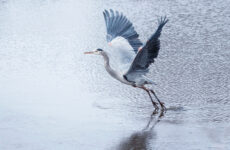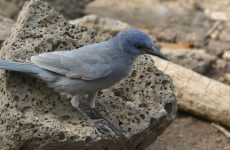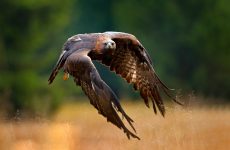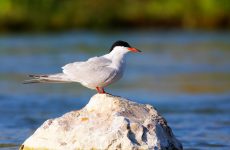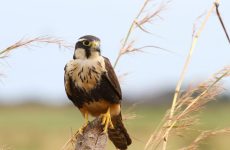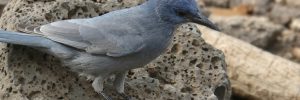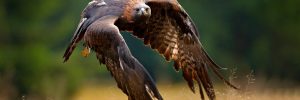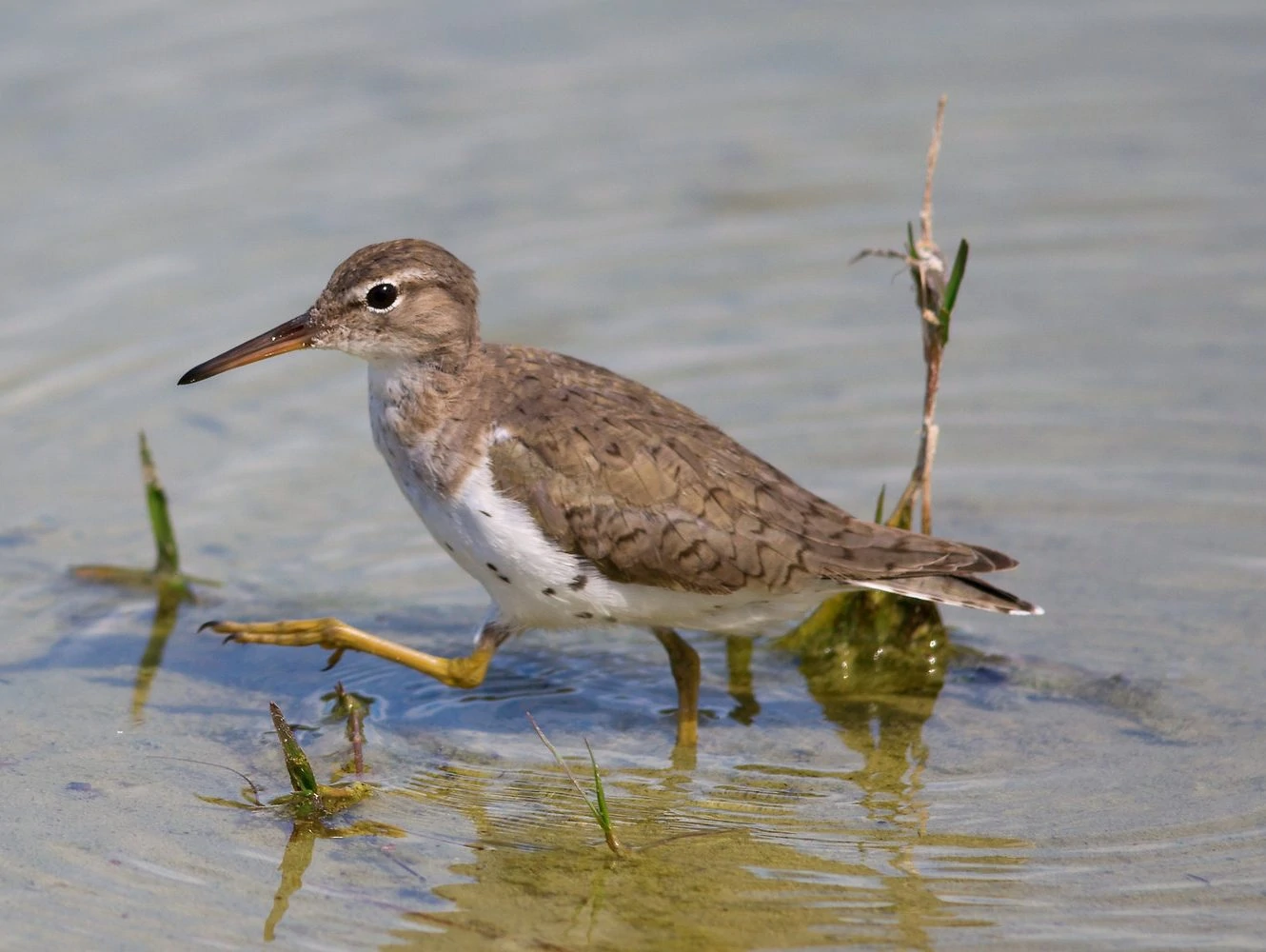
Shorebirds are found wandering along our lake shores, beaches, marshes, and wet areas and there are so many to identify. Often they are well camouflaged but are fun to watch zipping up and down and poking in the mud or stirring up a feast.
Shorebirds are also called waders as they are usually found in shallow water often no deeper than their bellies.
Shorebirds In Arizona In Summer: Black-necked Stilt, American Avocet
Shorebirds In Arizona In Winter: Least Sandpiper, Sora, Wilson’s Snipe, Dunlin, Mountain Plover
Shorebirds In Arizona All Year: Killdeer, Virginia Rail
Shorebirds In Arizona In Migration: Spotted Sandpiper, Long-billed Dowitcher, Greater Yellowlegs, Western Sandpiper, Wilson’s Phalarope, Lesser Yellowlegs, Long-billed Curlew, Solitary Sandpiper, Red-necked Phalarope, Willet, Semipalmated Plover, Pectoral Sandpiper, Marbled Godwit, Snowy Plover, Sanderling, Black-bellied Plover
Shorebirds include sandpipers, plovers, oystercatchers, turnstones, knots, curlews, dowitchers, avocets, and phalaropes and there are 81 species that occur in the Americas.
You will also find other birds near water in Arizona such as ducks, herons, pelicans, swans, and geese.
The easiest to identify are stilts, avocets, and oystercatchers and the hardest are usually the sandpipers, affectionately known as ‘peeps’
The calls of shorebirds are also a great help when identifying birds so listen to the call recordings.
25 Shorebirds In Arizona
1. Killdeer
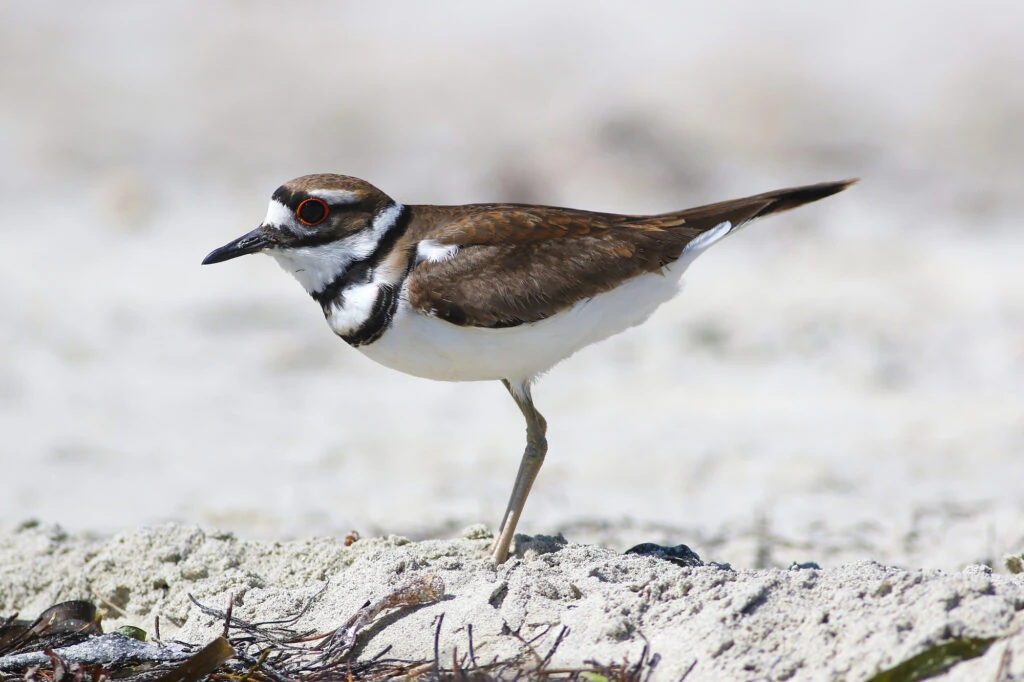
Killdeers are very common in Arizona and are spotted in the north of the state during the breeding season and in the south all year. They are recorded in 10% of summer checklists and 12% of winter checklists submitted by bird watchers for the state.
Killdeers are large plovers with distinctive red eye rings. They are brown on the top and white underneath and have 2 black breast bands and a black line through the eye.
They have long wings and tails and short thick dark bills. Males and females look the same.
- Charadrius vociferus
- Length: 7.9 – 11 in (20 – 28 cm)
- Weight: 2.6 – 4.5 oz (75 – 128 g)
- Wingspan: 18.1 – 18.9 in (46 – 48 cm)
Killdeer are year-round residents of the southern and western US states but those that breed in more northern regions migrate south for winter.
You can find Killdeers in open habitats with little to no vegetation, like pastures, fields, sandbars, and mudflats. Killdeers may be shorebirds but they’re often seen in urban environments..
Killdeer forage for insects in fields and often follow cattle or plows that disturb the soil hoping to capture earthworms that rise to the surface. In shallow water environments, they will shake one leg in the water, hoping to push their prey to the surface.
Killdeer calls:
Nests of Killdeer are usually simple, shallow scrapes with some added rocks, shells, and sticks placed on the ground in open areas.
The female lays four to six eggs that take three or four weeks to hatch. Chicks hatch with a single black breast band.
Fun Fact: In order to lure predators away from their nests, Killdeers are experts at pretending to have broken wings.
2. Least Sandpiper
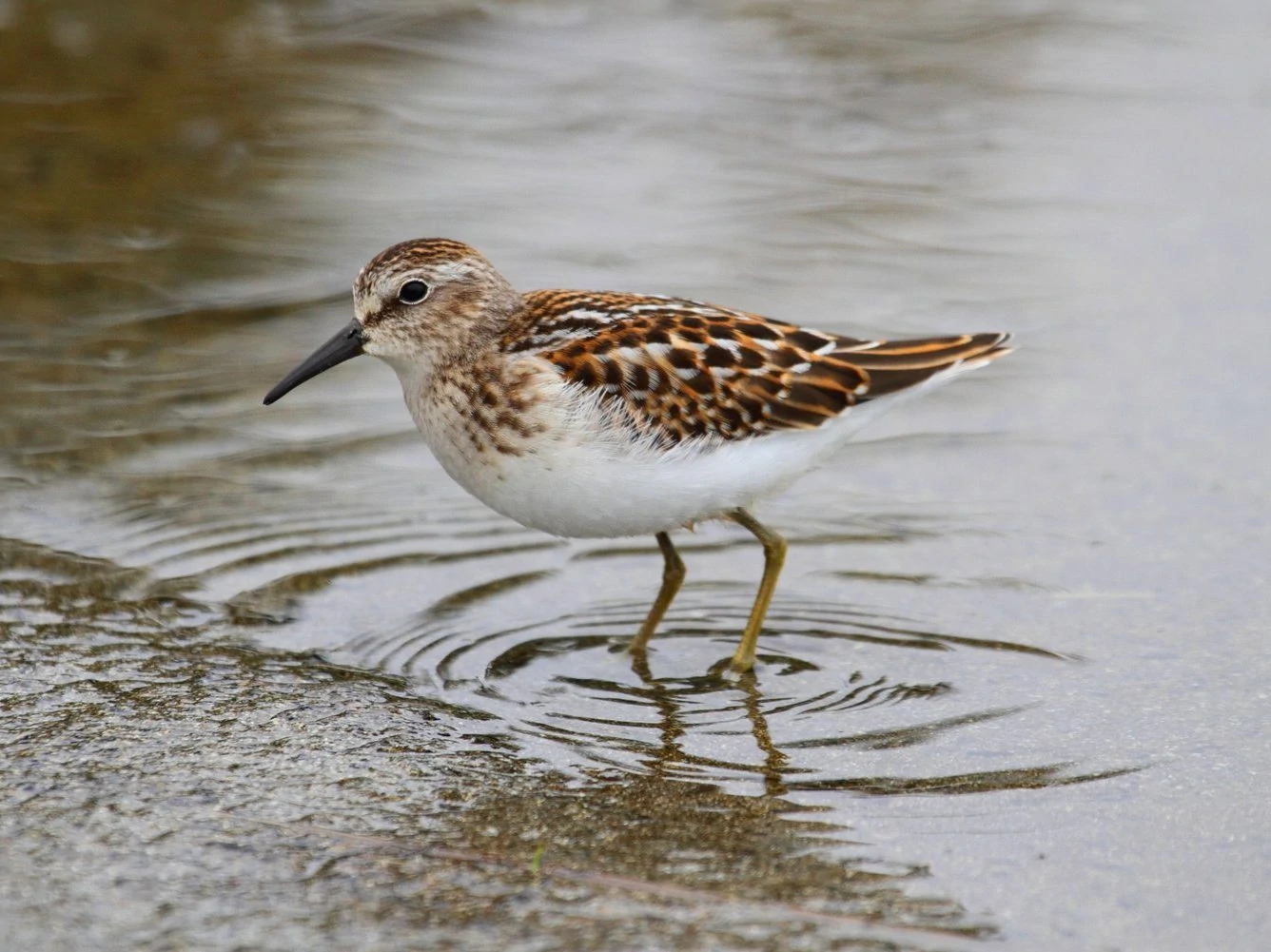
Least Sandpipers spend winter in the southwest of Arizona but they are also spotted across the rest of the state during migration. They appear in 5% of winter checklists.
Least Sandpipers are the smallest shorebirds. Breeding adults are rusty-brown with scaled patterns on their heads and upperparts and some brown streaking on their throats and breasts. Their bellies and undertails are white and they have yellow legs.
Non-breeding adult Least Sandpipers have a paler coloring, somewhat gray or light brown. Juveniles are brighter colored on their backs and their scaled patterns are more obvious.
- Calidris minutilla
- Length: 5.1 – 5.9 in (13 – 15 cm)
- Weight: 0.7 – 1.1 oz (19 – 30 g)
- Wingspan: 10.6 – 11.0 in (27 – 28 cm)
Least Sandpipers breed in Canada and the Great Plains before migrating to the US coast, southern US states Central and northern North America.
You can find Least Sandpipers in the tundra and boreal forests during their breeding season. In the winter, they inhabit lagoons, mangrove forests, mudflats, salt marshes, and edges of lakes, ponds, and rivers.
Least Sandpipers mostly probe and pick out their food from mudflats and beaches in winter and they forage in the tundra, eating flies, beetles, and dragonflies in summer.
Least Sandpiper Calls:
Nests of Least Sandpipers are made by males on patches of grass on damp ground. The female then lays three or four eggs which take about twenty days to incubate.
Females incubate at night, while males take the rest of the day. The female leaves the brood first and the males stay until the young fledge.
Fun Fact: When probing in the mud with their bills, Least Sandpipers use the surface tension of the water to bring their prey quickly from their bills to their mouths.
3. Black-necked Stilt
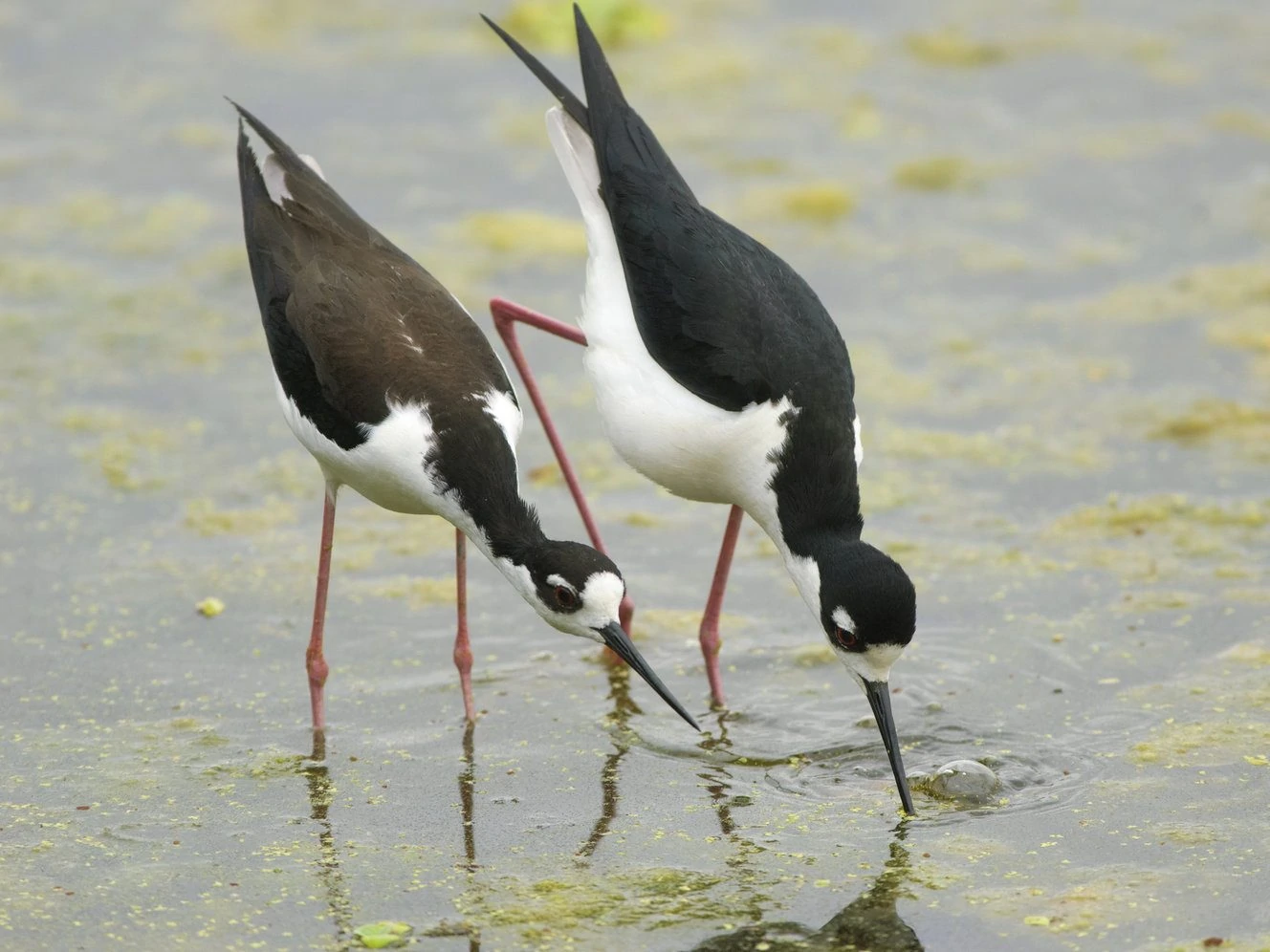
Black-necked Stilts are spotted in Arizona all year but their numbers increase in April and mid-August to September with more birds migrating through. They occur in up to 4% of summer and winter checklists.
Black-necked Stilts are fragile-looking black and white shorebirds with long and thin reddish-pink legs.
Males and females look similar except that females are brown-tinged instead of black. Juveniles look similar to adults but they have a faint scalloped pattern on their backs and they have paler legs.
- Himantopus mexicanus
- Length: 14 – 15.5 in (36 – 39 cm)
- Weight: 5.3 – 6.2 oz (150 – 180 g)
- Wingspan: 25 – 27 in (64 – 69 cm)
Black-necked Stilts that breed in the US and southern Canada migrate south for winter but those along the southwestern US coast, Gulf Coast, and Central, and South America remain all year.
You can find Black-necked Stilts in shallow wetlands with limited vegetation like flooded areas near rivers, shallow lagoons, saltmarshes, mangrove swamps, and mudflats. They also visit agricultural fields, sewage ponds, and rice fields.
Black-necked Stilts usually wade in shallow water to capture small crustaceans, snails, amphibians, and small fish. Occasionally, they will also eat insects and frogs.
They will submerge their heads in water or move their bills side to side to capture their prey. They are also known to chase fish into the shallows where they have a better chance of capturing them.
Black-necked Stilt Calls:
Nests of Black-necked Stilts are found near water and they make a depression on the ground lined with grass, shells, and pebbles. The female lays two to five eggs that take around four weeks to hatch.
Fun Fact: Black-necked stilts have the second longest legs of any bird, in proportion to their bodies. Flamingos have the longest legs.
4. Spotted Sandpiper

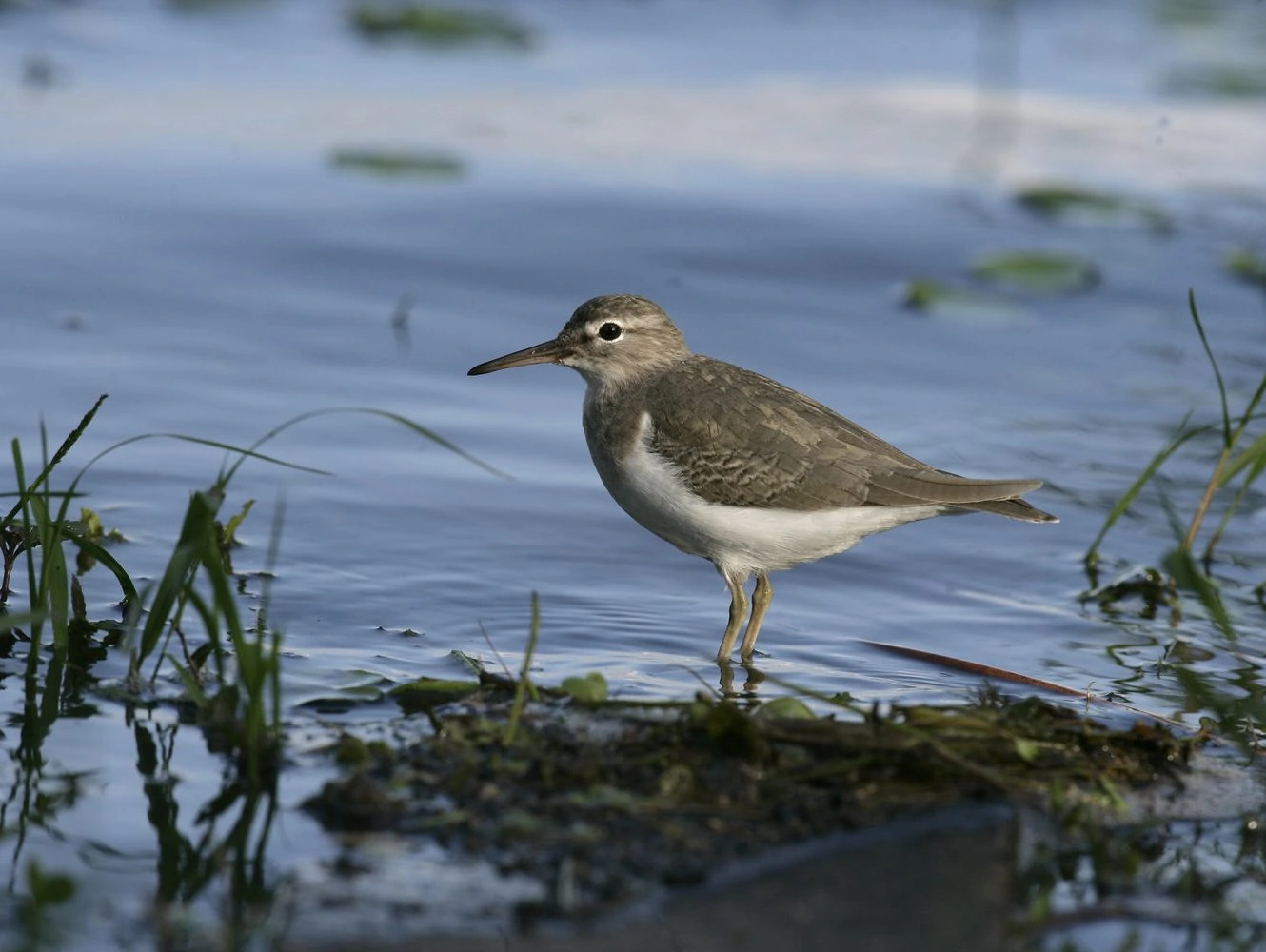
Spotted Sandpipers are most common in Arizona during migration in May and September but they are also spotted in the southwest of the state all year.
Spotted Sandpipers are slender, medium-sized shorebirds with brown spots on their white undersides. They have a distinctive dancing walk
Their backs are brown. They have a distinctive white stripe over the eye.
Non-breeding adults and juvenile Spotted Sandpipers are similar in that they have no spots and have light brown coloring on their backs and chest.
While males and females are also similar, females tend to be larger and heavier than males.
- Actitis macularius
- Length: 7.1 – 7.9 in (18 – 20 cm)
- Weight: 1.2 – 1.8 oz (34 – 50 g)
- Wingspan: 14.6 – 15.8 in ( 37 – 40 cm)
Spotted Sandpipers breed in Canada and the US before migrating to the Gulf Coast, Mexico, and Central, and South America.
You can find Spotted Sandpipers in any freshwater area, like rivers and streams. They are also often seen near coastal areas, especially in winter.
Spotted Sandpipers normally forage on sand or mud and eat small fish and crustaceans, but will also eat insects from leaves.
Spotted Sandpiper Calls:
Nests of Spotted Sandpipers are always located near the shore and under the protection of broad-leafed plants or under thick vegetation like nettles. Nests are simple scrapes on the ground and lined with dead grass, feathers, and weeds.
The female lays three to five eggs but the male incubates them for about three weeks and continues to care for them as they grow. Females may mate with more than one male.
Fun Fact: Spotted Sandpipers are sometimes called “teeter-tails” because of their distinct tail-bobbing or “teetering” motion while they’re foraging.
5. Long-billed Dowitcher
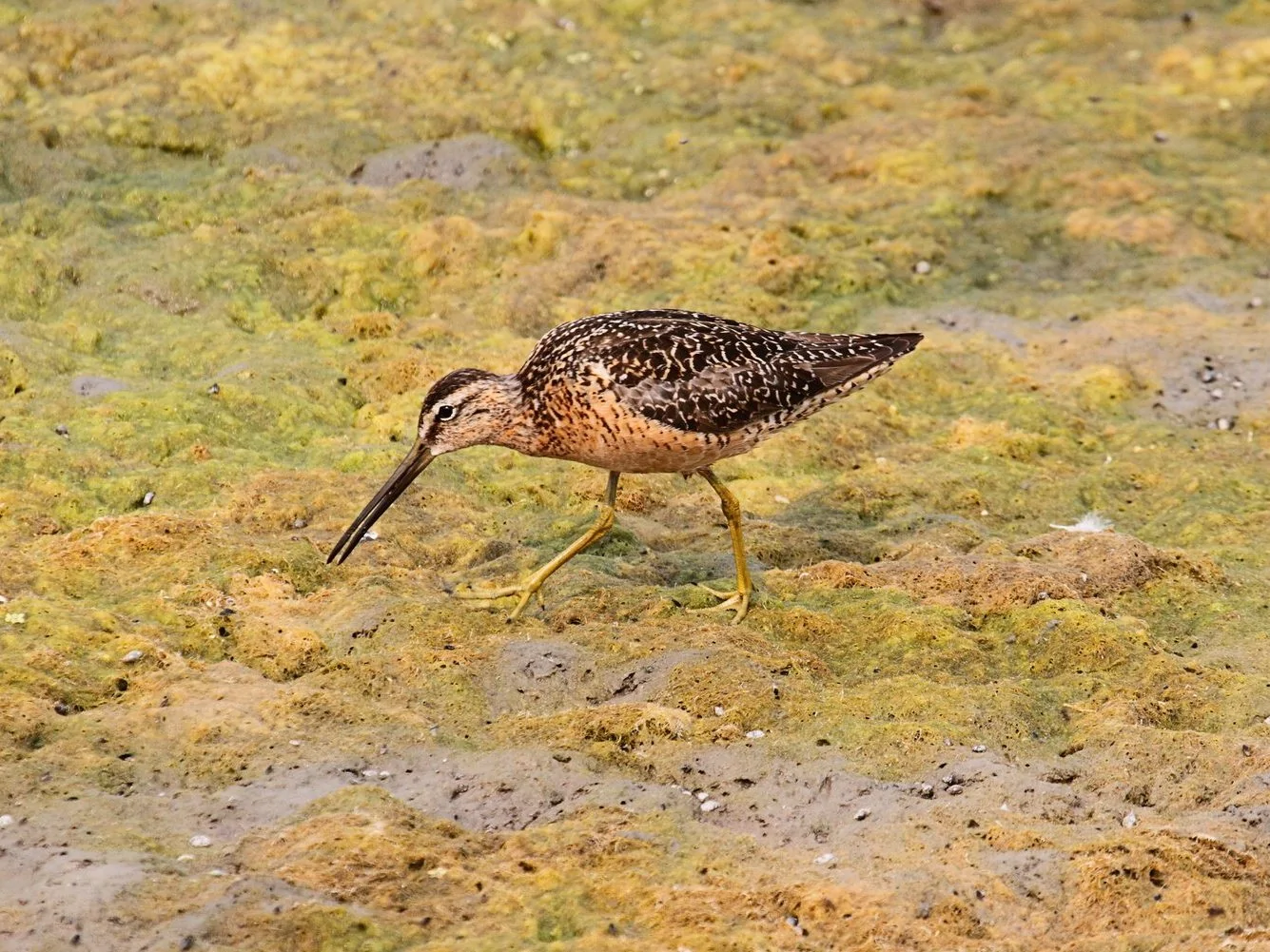
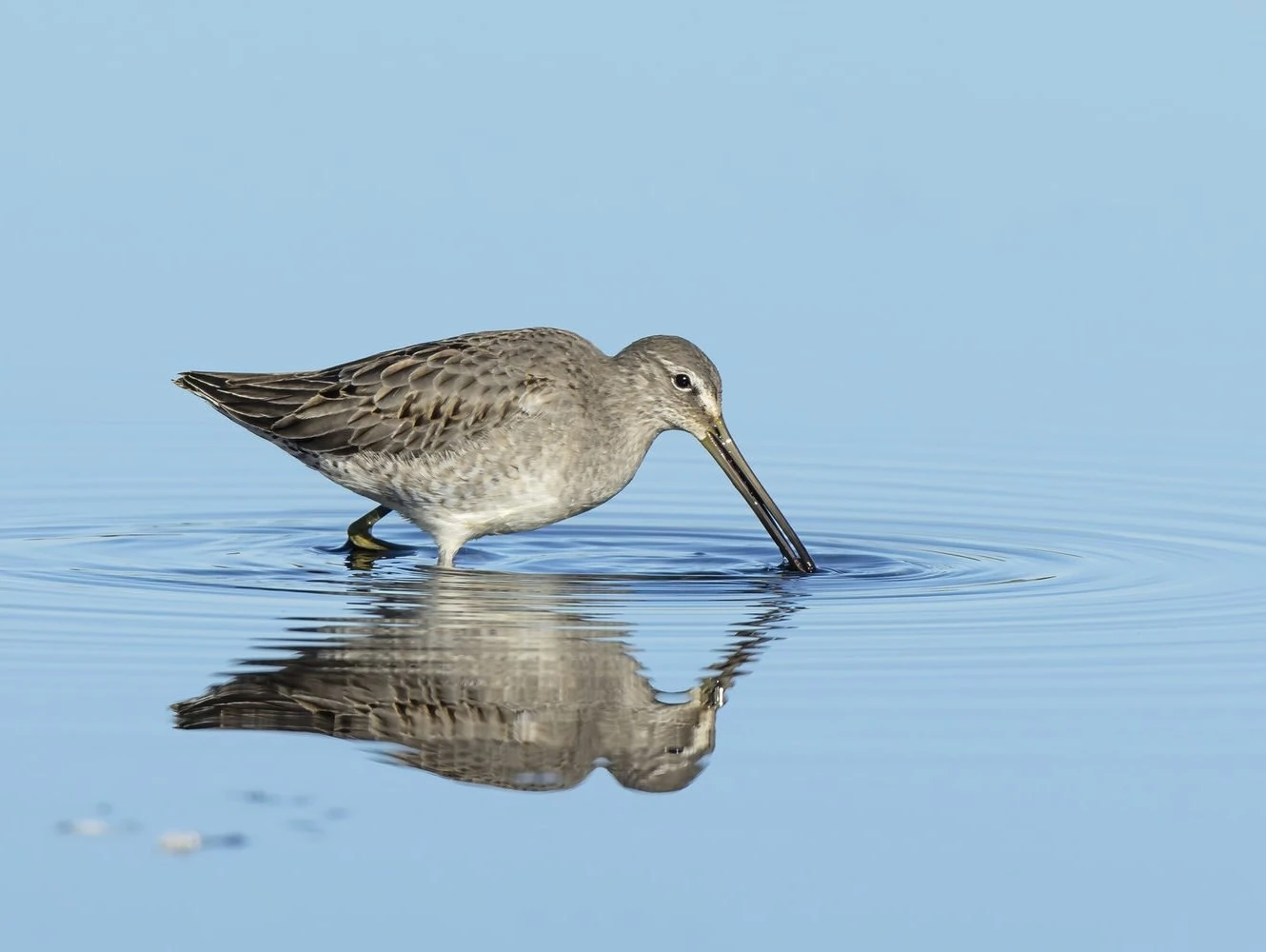
Long-billed Dowitchers are usually spotted in Arizona during migration but they also spend winter in the southwest of the state.
Long-billed Dowitchers are aptly named because their black bills are twice as long as their heads. Breeding adult Long-billed Dowitchers have a beautiful rusty-orange color and are darker on the back.
Non-breeding adult Long-billed Dowitchers are generally gray overall. Juveniles are a combination of breeding and non-breeding adults. They have grayish heads and breasts like the non-breeding adults but are mottled brown and cinnamon on top like the breeding ones.
- Limnodromus scolopaceus
- Length: 11 – 12.5 in (28 – 32 cm)
- Weight: 4.76 oz (135 g)
- Wingspan: 18 – 20 in (46 – 51 cm)
You can find Long-billed Dowitchers in muddy wet areas such as wet meadows, tidal flats, and marshes. They prefer shallow freshwater areas than saltwater.
Long-billed Dowitchers mostly eat insects like beetles, caterpillars, and midges and their larvae. When they probe the wet and muddy ground, they can capture mollusks, clams, marine worms, and some plants.
Their bills are very sensitive and they have excellent night vision so they can take advantage of foraging at night.
Long-billed Dowitcher Calls:
Nests of Long-billed Dowitchers are shallow depressions lined with grass, usually located on elevated grounds near small ponds. The female lays four eggs and they take twenty days to hatch. Once they’re hatched, it’s the male that takes care of the chicks until they fledge.
Fun Fact: The Long-billed Dowitcher used to be indistinguishable from the Short-billed Dowitcher but now they are recognised as separate species. There call is different is the best way to tell.
6. American Avocet
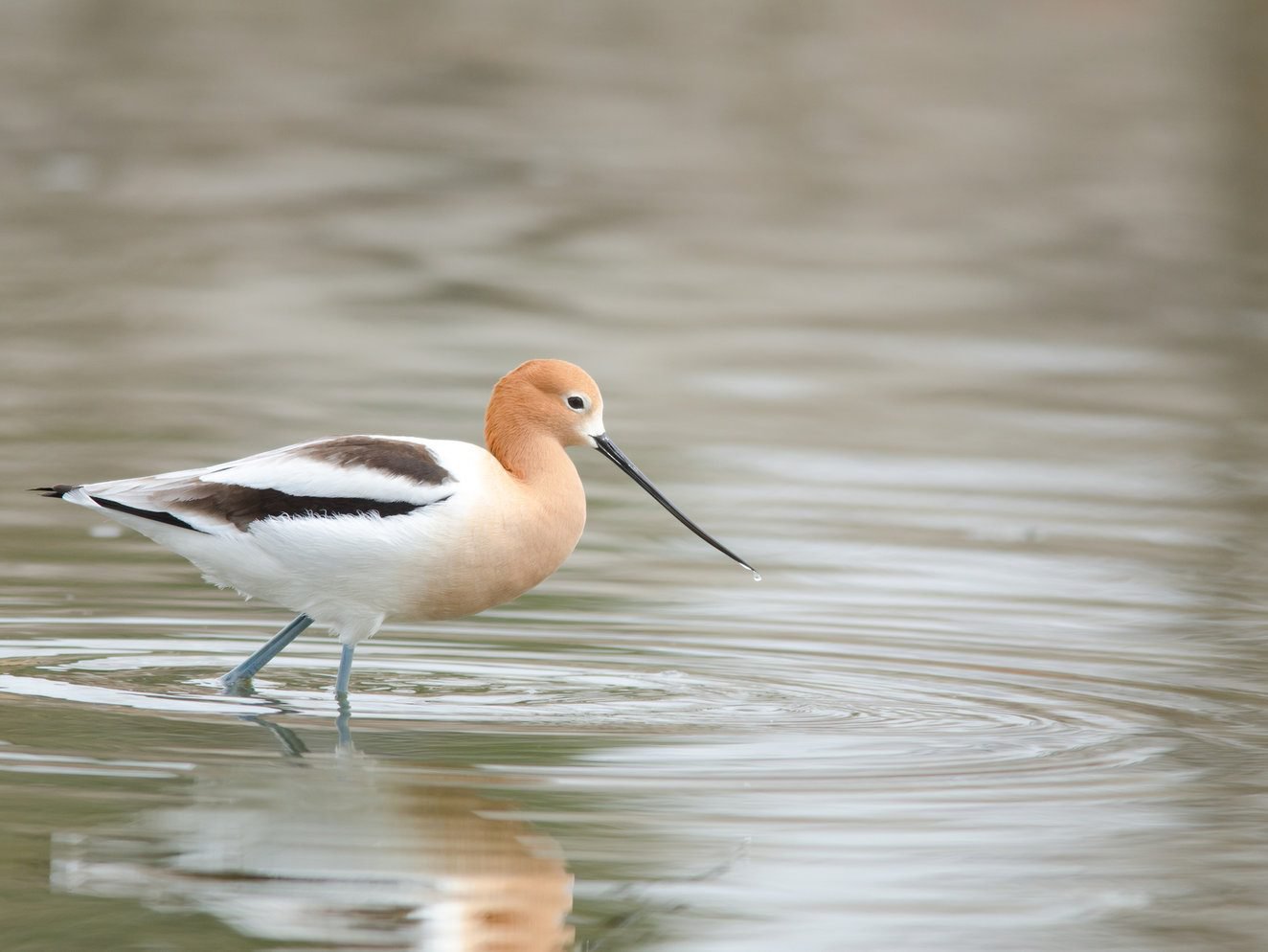
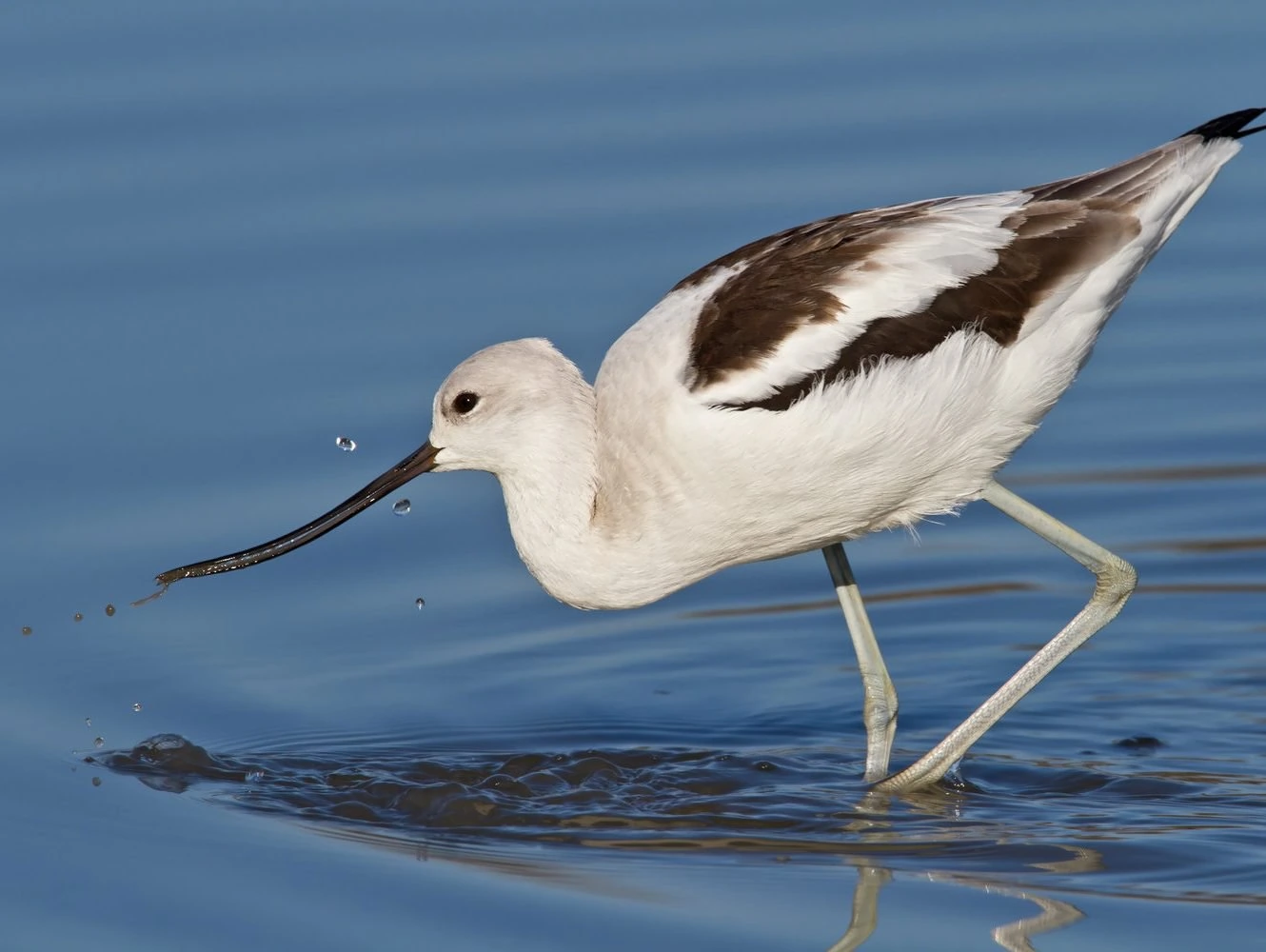
American Avocets spend the breeding season in Arizona but they also hang around all year in the south of the state.
American Avocets are elegant black and white birds with long black bills and blue-gray legs. Breeding adults have oranged tinged heads and breasts.
Juveniles look more like older chicks, in that they have grayish-brown and downy feathers. Their bills are also still straight, without the upward curve at the end.
- Recurvirostra americana
- Length: 18 – 20 in (46 – 51 cm)
- Weight: 11.1 oz (315 g)
- Wingspan: 27 – 38 in (69 – 97 cm)
American Avocets breed inland predominantly in western and central US states and spend winter along the Gulf Coast and Central American Coasts.
You can find American Avocets in shallow water that’s less than eight inches deep. Breeding grounds are in areas with little vegetation.
During winter, you may find them in rice fields, flooded pastures, intertidal mudflats, and tidal lagoons.
American Avocets forage for food while wading or swimming in shallow water. They usually catch small fish, shrimp, and seeds.
They move their bills from side to side in the water (called “scything”) to capture prey in their partially open bills.
American Avocet Calls:
Nests of American Avocets are scrapes on the ground, usually located on islands or mucky shorelines and close to the water, and lined with feathers or pebbles.
The female then lays up to four eggs that take three to four weeks to hatch. Young chicks can fend for themselves immediately after being born.
Fun Fact: American Avocets nest in loose colonies and defend their territories as a group. If a predator manages to penetrate the colony, it will find itself surrounded by several adult avocets trying to distract it.
7. Greater Yellowlegs
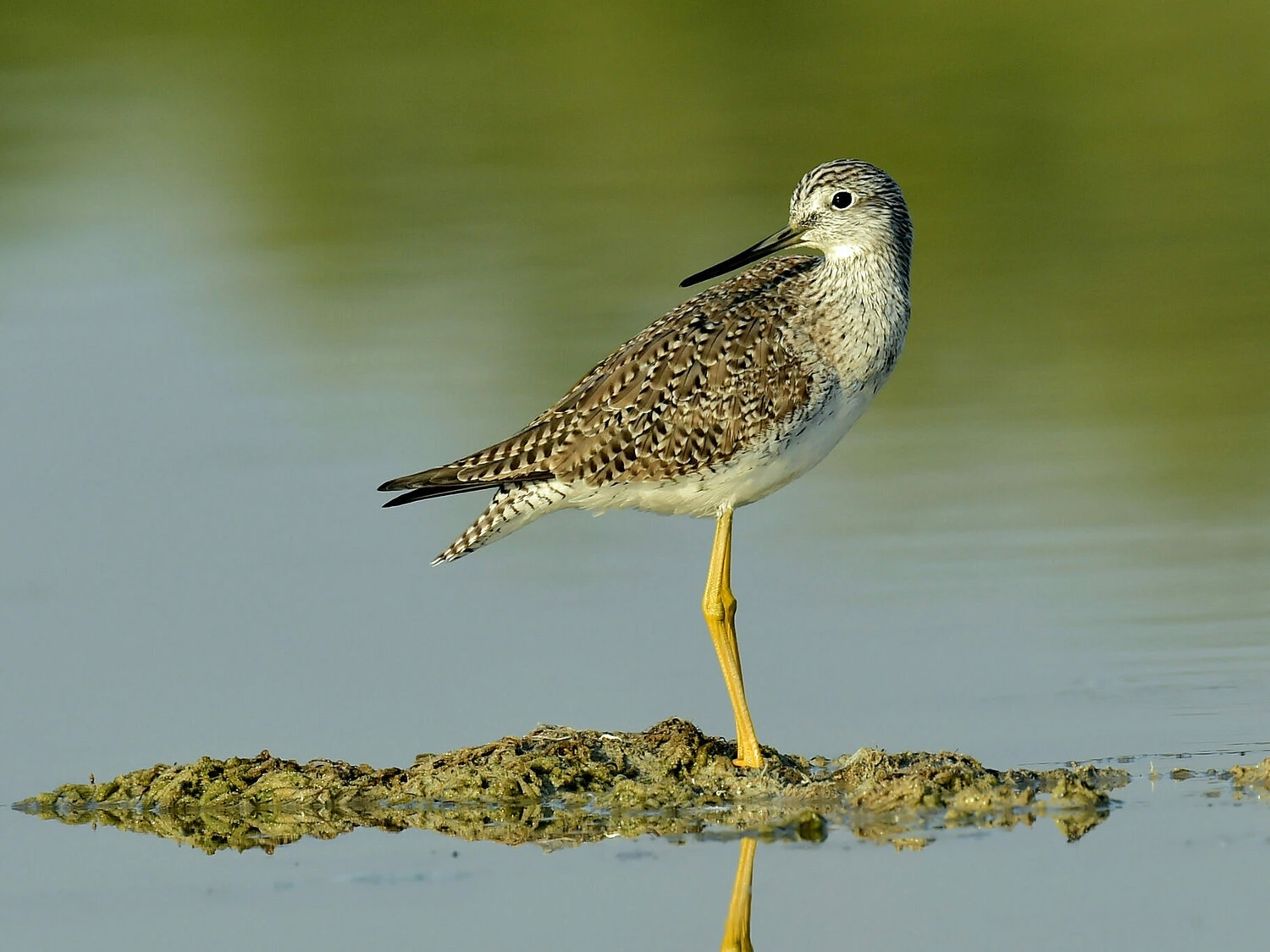
Greater Yellowlegs are mainly spotted in the southwest of Arizona during winter but they are also spotted across the state during migration.
Greater Yellowlegs are larger than the similar Lesser Yellowlegs. Adult Greater Yellowlegs are lanky, with long, yellow legs, and thick, long slightly upward-curved bills.
They are generally finely streaked on the head and neck with some heavy streaking with brown on their throats. Their upperparts are speckled with brown and gray while their underparts are plain white.
Breeding adults normally have darker and denser streaking on the breast and neck with additional heavy streaks on their flanks.
- Tringa melanoleuca
- Length: 11.4 – 13.0 in (29 – 33 cm)
- Weight: 4.5 – 7.7 oz (128 – 219 g)
- Wingspan: 23.6 in (60 cm)
Greater Yellowlegs that breed in Canada and the United States generally migrate to the Gulf Coast and Central America. They are also found in South America.
You can find Greater Yellowlegs in wetland habitats like tidal flats, wet meadows, and flooded agricultural fields.
Greater Yellowlegs usually wade in shallow water and use their long bills to poke at and stir the water to capture crustaceans, marine worms, and frogs. They also eat small fish and insects, seeds and berries.
Greater Yellowlegs calls:
Nests of Greater Yellowlegs are found on the ground near water and lined with leaves and lichen. They lay up to four eggs which take about twenty-three days to hatch.
Once they hatch, the chicks are able to leave the nest after a few hours and can feed themselves.
Fun Fact: Greater Yellowlegs are easy to spot not only for their yellow legs but also for their striking high-stepping gait across the muddy wetlands.
8. Sora
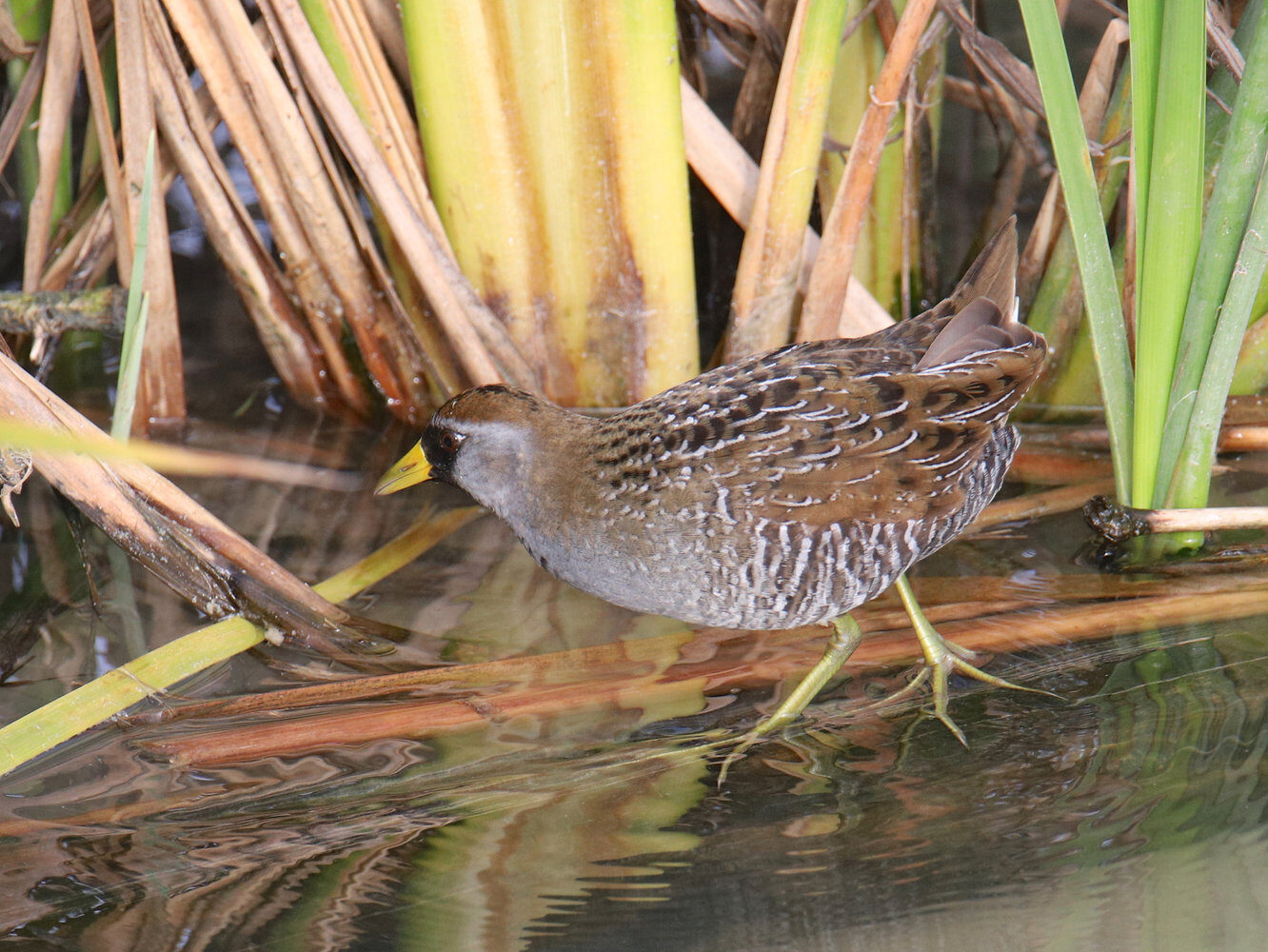
Soras are usually spotted in the south of Arizona during winter but there are also some sightings in the state all year.
Sora are usually heard rather than seen, but their plump brown and gray bodies and bright yellow bills are easy to identify given the chance.
They are the most abundant rail in North America, not that you are likely to see them!
- Porzana carolina
Sora breed in Canada and most of the US and spend winter in the coastal southern United States, Mexico and Central and northern South America.
You can find sora in freshwater wetlands walking slowly and exposing their white undertail feathers with a flick of the tail.
Soras eat seeds mainly but will also aquatic insects and invertebrates given the chance.
Sora calls:
Nests of Sora are made on mounds from woven cattails and sedges at the edges of wetlands.
Fun Fact: Soras find a mate by staring for at each other for as long as half an hour.
9. Wilson’s Snipe
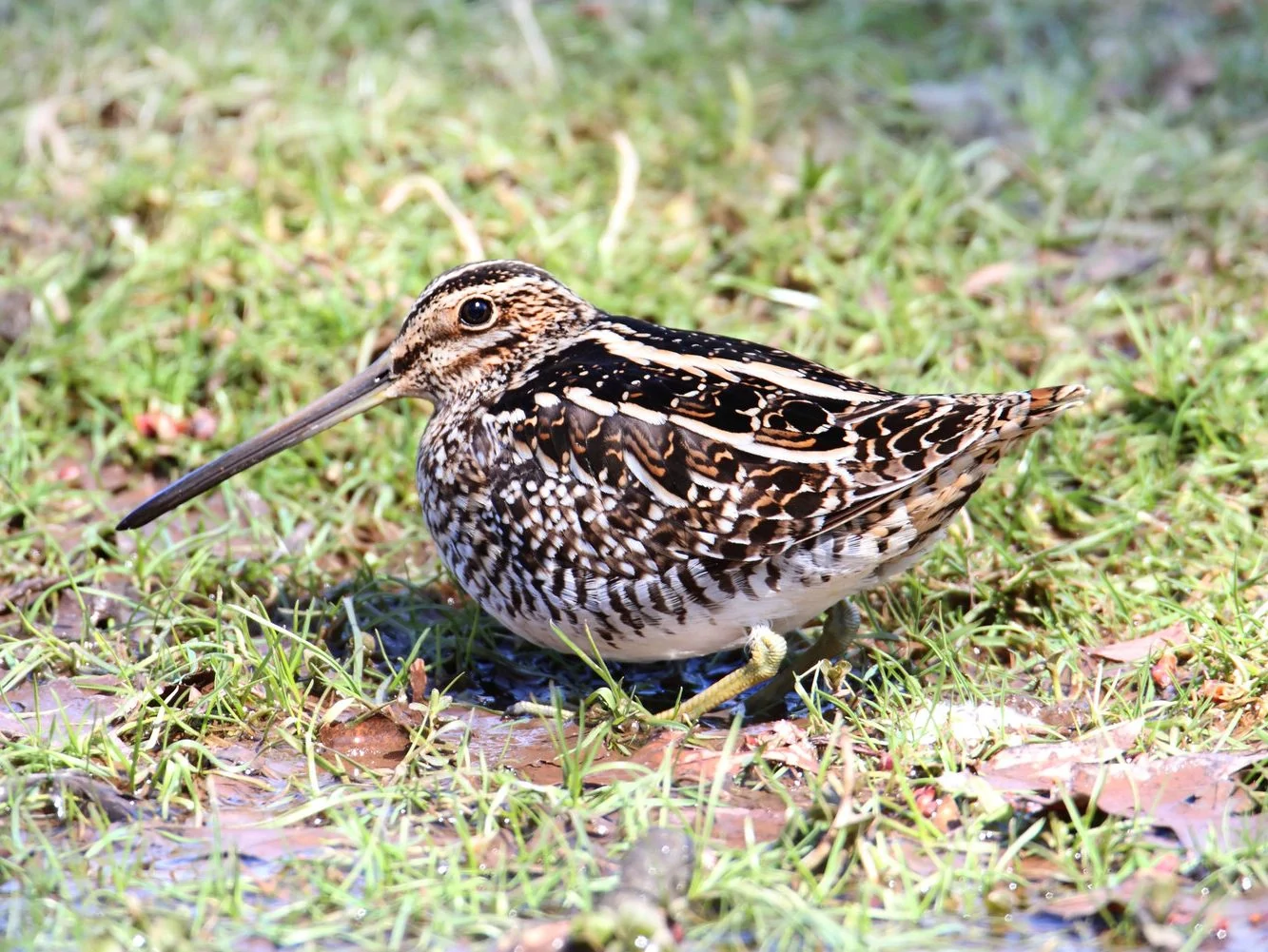
Wilson’s Snipes spend winter in the south of Arizona and are most common from October to April. They are spotted in 2% of checklists at this time.
Wilson’s Snipes are small, stocky shorebirds that are known for the “winnowing” sounds their fanned-out outer tail feathers make when they’re flying fast. Wilson’s Snipes may be small and short but they can fly extremely fast with speeds estimated at 60 miles an hour.
Though they may be difficult to spot due to their brown mottled and streaked camouflage their extremely long bills help them stand out. Adults and juveniles are similar.
- Gallinago delicata
- Length: 10 – 11 in (25 – 28 cm)
- Weight: 6.38 oz (181 g)
- Wingspan: 17 – 20 in (43 – 51 cm)
Wilson’s Snipe breed in Canada and northern US states before migrating to the US coast, southern and eastern US states, and Central America.
You can find Wilson’s Snipes in freshwater marshes, muddy swamps, and damp fields with vegetation to hide in. When flushed out, they will fly in a zigzag motion to confuse predators.
Wilson’s Snipes forage in muddy soil in search of larval insects, crustaceans, earthworms, and mollusks. They plunge their long bills deep into the ground, sometimes up to their eyes, and simply swallow their prey without lifting the bills.
Wilson’s Snipe Calls:
Nests of Wilson’s Snipes are scrapes made by the female and lined with grass which she adds onto with every egg laid. She lays two to four eggs and incubates them for about twenty days.
Fun Facts: The eyes of a Wilson’ Snipe are set far back on its head to allow it to dig deeply into the mud with its long bill. With this, it can see well from all angles, even from the back.
10. Western Sandpiper
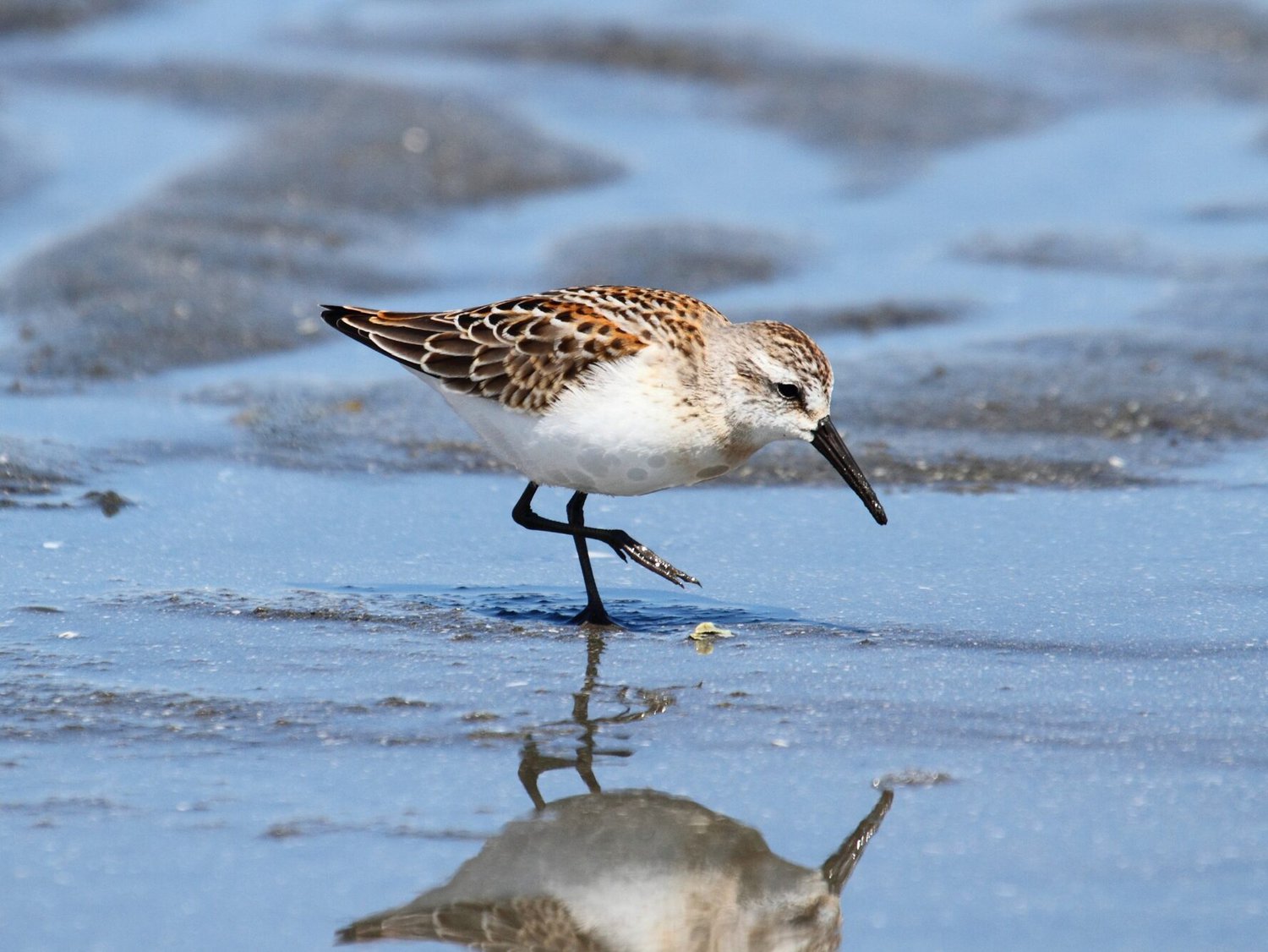
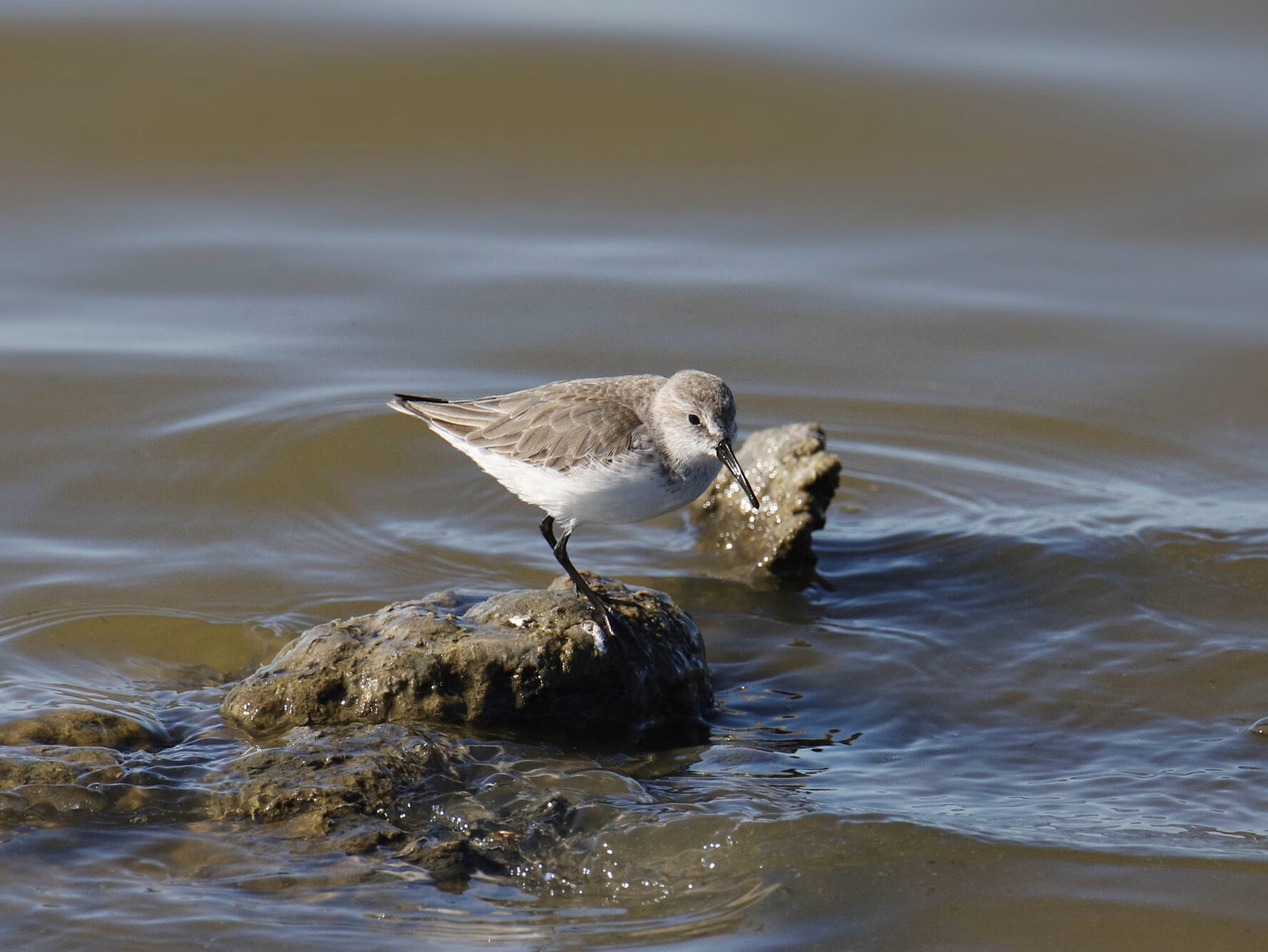
Western Sandpipers are spotted in Arizona during migration from April to May and July to November but some hang around all year around Phoenix and Tucson.
Western Sandpipers, especially those in breeding plumage, are considered the most colorful of tiny North American “peeps”.
They are also one of the most abundant shorebirds in North America.
Breeding Western Sandpipers are scalloped brown, black, white and gold on their backs and wings and are white underneath and have short dark legs. In flight, they have a black stripe down the center of the tail.
Nonbreeding adults are hard to distinguish from Semipalmated Sandpipers in their winter plumage. They are both pale gray above and white below. Western Sandpipers have few streaking on their breast.
Juveniles are more similar to nonbreeding adults but their backs are more scaly-looking.
- Calidris mauri
- Length: 5.5 – 6.7 in (14 – 17 cm)
- Weight: 0.8 – 1.2 oz (22 – 35 g)
- Wingspan: 13.8 – 14.6 in (35 – 37 cm)
Western Sandpipers breed mainly in Alaska and western Canada and migrate to the Pacific and Atlantic US coast, Central and South America, and the Caribbean.
You can find Western Sandpipers in dry tundra with plenty of sedges and grasses during the nesting season. During migration, they congregate in flocks of thousands around beaches and marshes.
Western Sandpipers hunt in very shallow water. With females having longer bills, they tend to forage by probing more. Males often hunt visually and resort to pecking to capture their prey. They eat insects, spiders, crustaceans, mollusks, and marine worms.
Western Sandpiper call:
Nests of Western Sandpipers are depressions on the ground concealed under some vegetation and lined with soft material. The female will lay two to four eggs and both parents will share in the responsibility of incubating the eggs for three weeks.
Chicks hatch and are able to feed themselves. They take about three weeks to learn how to fly.
Fun Facts: Female Western Sandpipers are larger and have longer bills than males.
11. Wilson’s Phalarope
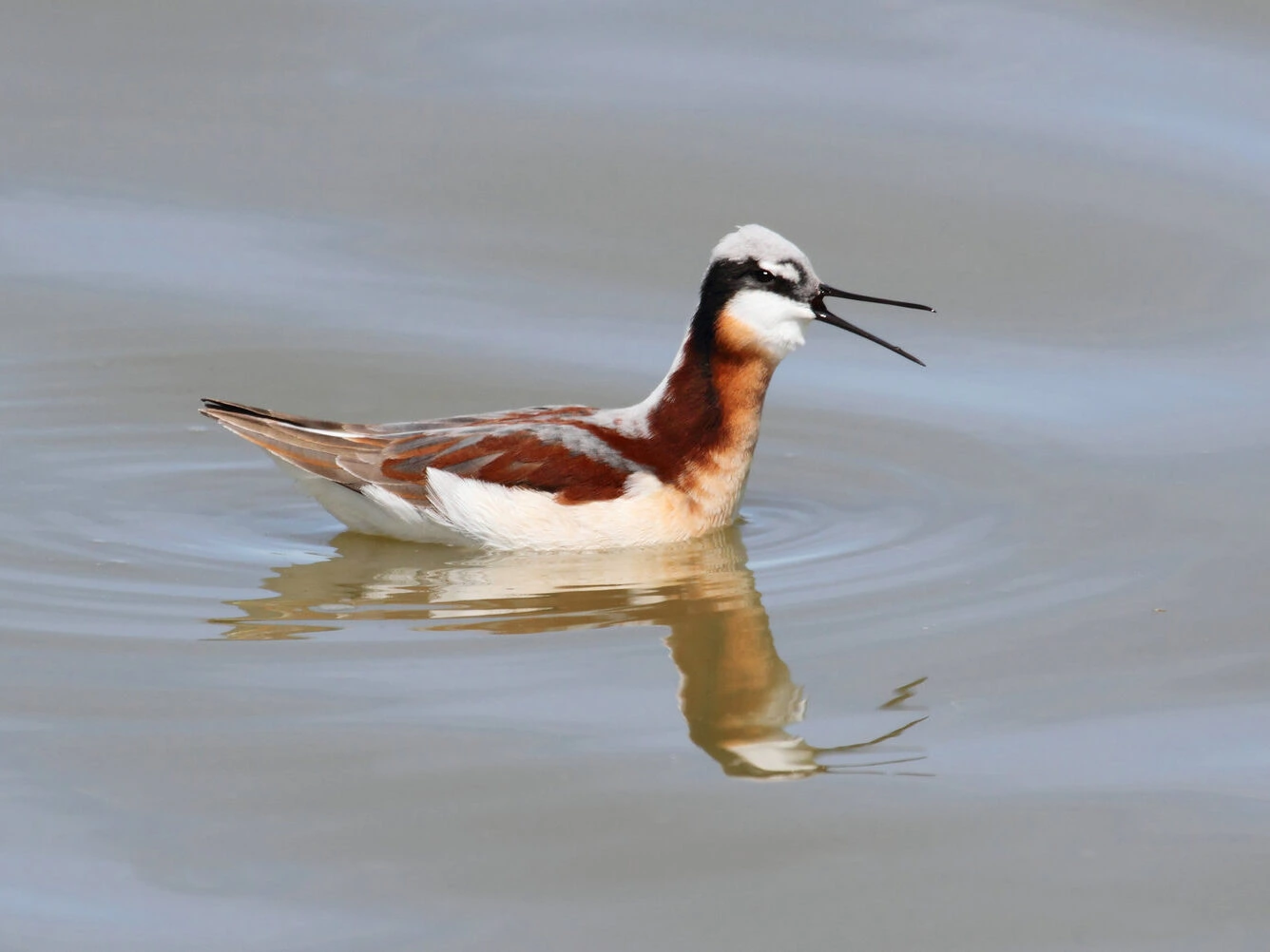
Wilson’s Phalaropes are usually seen in Arizona from April to September. They are spotted here during summer and migration.
Wilson’s Phalaropes are eye-catching birds and the largest of the phalaropes, you will see them spinning around kicking up food. They have small heads, long necks, thin, straight black bills, and long black legs.
Females are more colorful and larger than males and they leave the rearing of young to them.
Breeding females have gray crowns, white faces, peach or light cinnamon necks, blue-gray upperparts, white underparts, and reddish flank patches and a black stripe on their face and neck.
Breeding male Wilson’s Phalaropes are less colorful than females. They do not have the neck stripe and the reddish flank patches.
Nonbreeding adults are mostly gray on their crowns and upperparts. Their underparts are white. Juveniles have brown caps, scaled pattern gray, brown, and rufous upperparts, and white underparts.
- Phalaropus tricolor
- Length: 8.7 – 9.4 in (22 – 24 cm)
- Weight: 1.3 – 3.9 oz (38 – 110 g)
- Wingspan: 15.3 – 16.9 in (39 – 43 m)
Wilson’s Phalaropes breed mainly in western US and Canada before migrating to southern South America.
You can find Wilson’s Phalaropes in salt marshes during winter. During the breeding season, they breed in wetlands and shrubby areas.
Though Wilson’s Phalaropes are shorebirds, they spin round and round in the water creating a whirlpool that brings midges, shrimp, and seeds to the surface.
While on the shore, they pick off prey from the surface or probe the soft mud.
Wilson’s Phalarope call:
Nests of Wilson’s Phalaropes are usually on the ground in freshwater marshes. The female selects the site and lays her eggs in a simple scrape on the ground. She lays three to four eggs and then migrates south.
The male stays and reinforces the nest, and incubates the eggs for about three to four weeks. The young can find their own food within a day of hatching.
Fun fact: With Wilson’s Phalaropes, the roles of females are reversed. They are more colorful and larger than males, take the lead in courtship, don’t incubate their eggs and they leave the rearing of their young to the male.
12. Virginia Rail
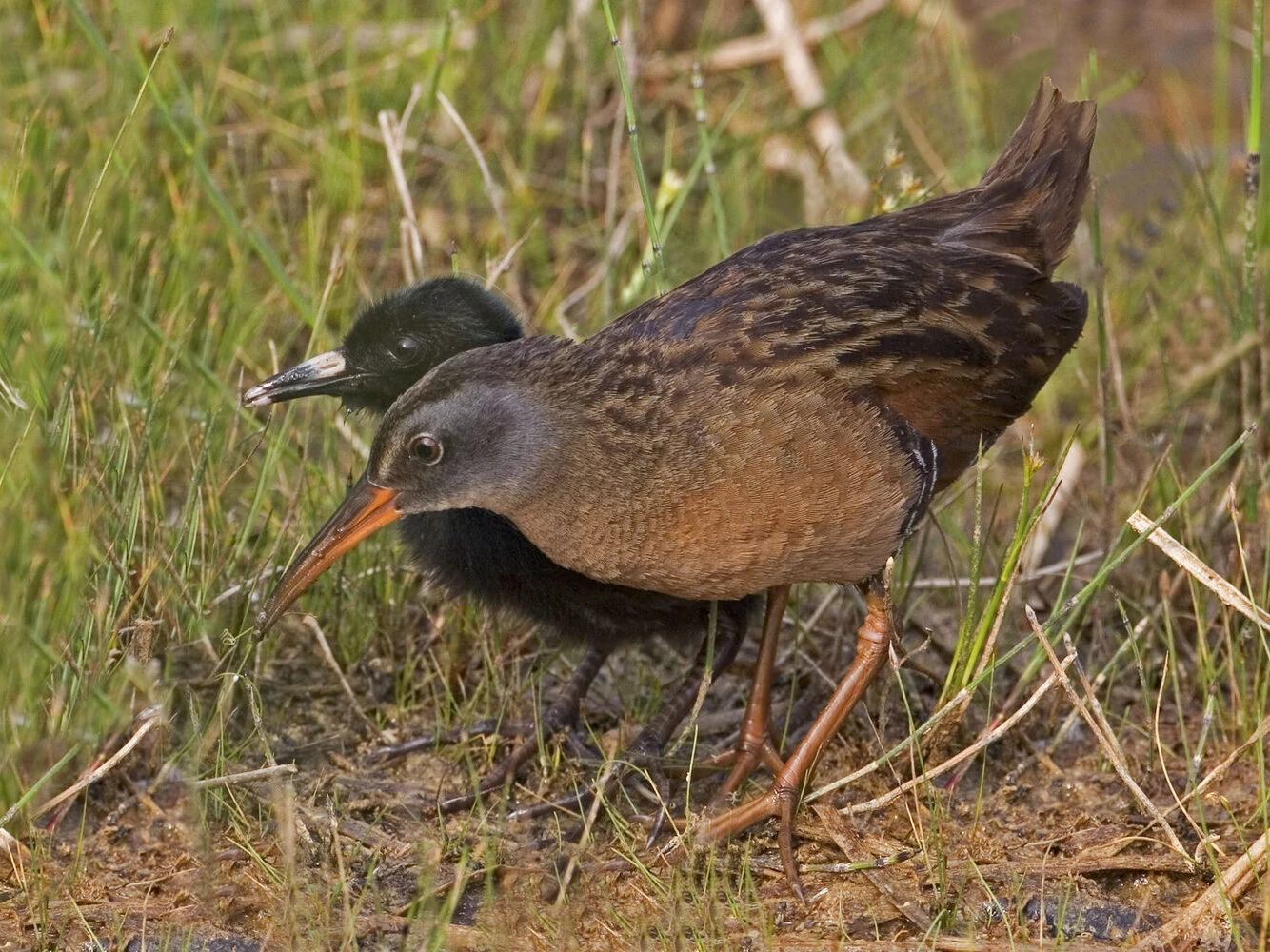
Virginia Rails have sightings in Arizona all year but they are most common from mid-September to March.
Virginia Rails are secretive chicken-like waterbirds that are fairly common but more often heard than seen.
Adults are generally rusty brown with gray faces and red-orange downward-curved bills. Their backs and wings are heavily streaked with brown.
Adults are similar but females are smaller. Juveniles are darker.
- Rallus limicola
- Length: 7.9 – 10.6 in (20 – 27 cm)
- Weight: 2.3 – 3.4 oz (65 – 95 g)
- Wingspan: 12.6 – 15.0 in (32 – 38 cm)
Virginia Rails breed in southern Canada and the northern United States and migrate to the southern US. Those in the western US remain all year.
You can find Virginia Rails in shallow freshwater and brackish marshes with tall stands of cattails and bulrushes. In winter, they may be found in coastal salt marshes.
Virginia Rails use their bills to probe the mud for food and mostly eat insects like beetles, flies, dragonflies, snails, and earthworms. During winter, they may supplement their diet with plants and seeds.
Virginia Rail call:
Nests of Virginia Rails are built on floating or dense clumps of vegetation. They’re usually in dry areas over very shallow water. Both adults weave cattails, reeds, and grasses together to create a basket-type of nest. They also weave a canopy of plant vegetation over the nest.
The female lays four to thirteen eggs which take about three weeks to hatch. They continue to care for their young for about two to three weeks after they hatch.
Fun Facts: Virginia Rails are slim and have adapted strong forehead feathers that are suited to constant wear and tear from pushing through dense vegetation
13. Lesser Yellowlegs
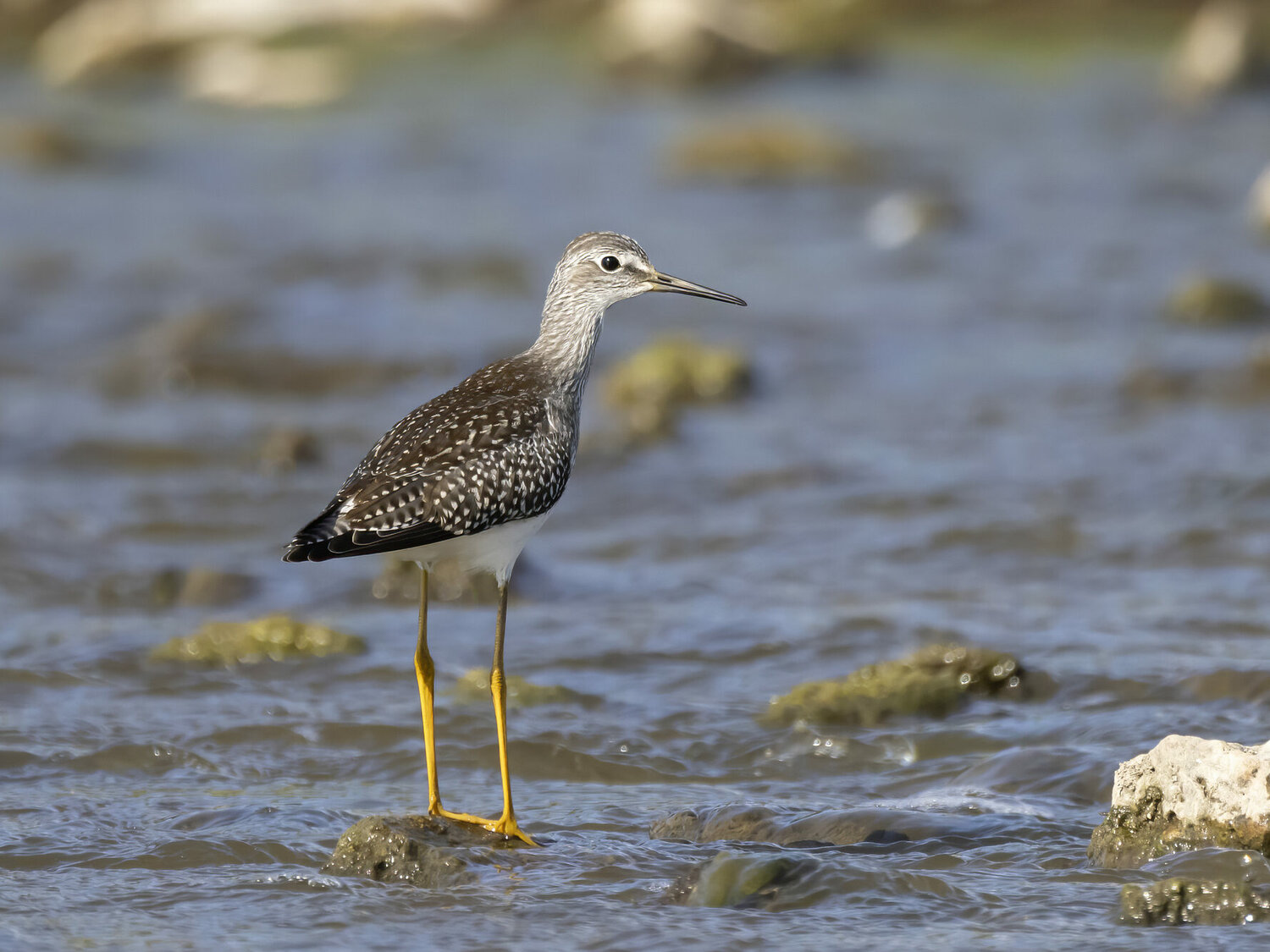
Lesser Yellowlegs are spotted in Arizona during migration from mid-March to April and July to November but a few hang around during winter around Phoenix.
Lesser Yellowlegs have shorter and more needle-like bills than the Greater Yellowlegs and are smaller.
Breeding adults have mottled gray-brown, black and white upperparts. They are white underneath with irregular brown streaking on the breast and neck. Their legs are yellow.
Non-breeding adults have more uniform gray-brown upperparts. But their necks and breasts have varying degrees of streaking with some barring on their flanks.
Juveniles have a dark brown smudgy cap and fine brown and white spotting on their backs. Their heads and breasts also look smudged with brown coloring and light streaking.
- Tringa flavipes
- Length: 9.1 – 10.6 in (23 – 27 cm)
- Weight: 2.8 – 3.2 oz (79.5 – 90.9 g)
- Wingspan: 23.2 – 25.2 in (59 – 64 cm)
Lesser Yellowlegs breed in Canada and the United States and migrate to southern US states, Central and South America.
You can find Lesser Yellowlegs in a variety of fresh and brackish wetlands, especially during migration and winter. During the breeding season, they open woodlands with nearby marshes and ponds.
Being shorebirds, Lesser Yellowlegs favor small fish, crustaceans, and small aquatic insects like dragonfly nymphs, beetles, and water boatmen. They also eat snails, worms, and seeds.
Greater Yellowlegs calls:
Nests of Lesser Yellowlegs are well-camouflaged simple depressions located on the ground, lined with dry grass, leaves, and moss. Females lay three to five eggs that take about twenty-two days to hatch. The chicks can leave their nest a few hours after hatching.
Fun Fact: The Lesser Yellowlegs used to be hunted regularly which led to their declining populations in the early 20th century. While their numbers have since increased, they are now threatened by the loss of their habitat.
14. Long-billed Curlew
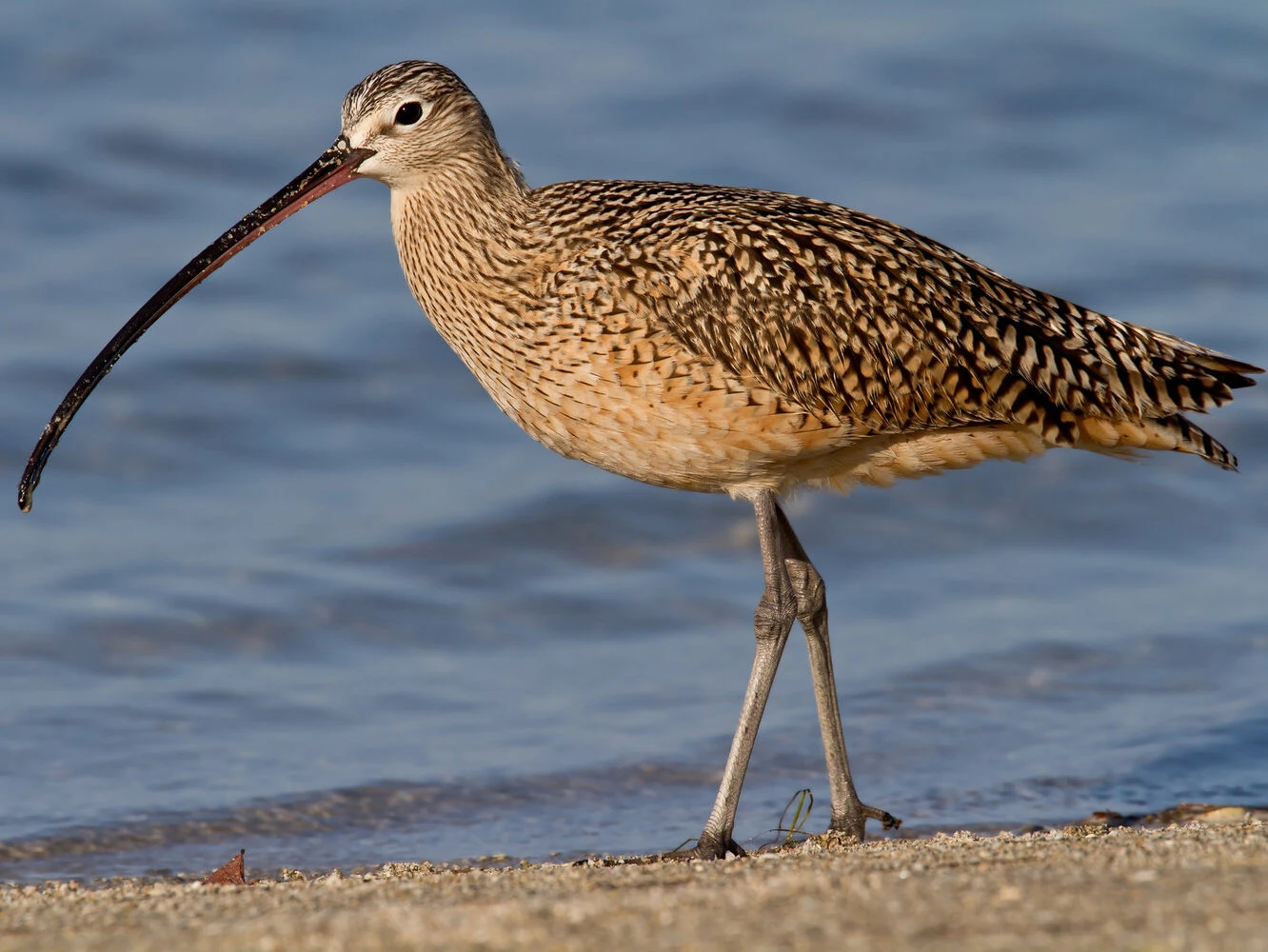
Long-billed Curlews migrate across Arizona but a few spend winter in the southeast of the state and a few hang around all year around Phoenix and Tucson.
Long-billed Curlews are the largest shorebirds in North America. They’re easily recognizable for their extremely long, thin, and downcurved bills.
Long-Billed Curlews have small heads, long necks, and brown streaked football-shaped bodies with a cinnamon wash on the flanks and belly.
Female Long-billed Curlews are much larger than males and have longer bills.
- Numenius Americanus
- Length: 19.7 – 25. 6 in (50 – 65 cm)
- Weight: 17.3 – 33.5 oz (490 – 950 g)
- Wingspan: 24.4 – 35.0 in (62 – 89 cm)
Long-billed Curlews breed in western US states and southwestern Canada before migrating to Mexico.
You can find Long-billed Curlews in wetlands, tidal estuaries, mudflats, and beaches. During the breeding season, they stay in dry grasslands and sagebrush prairie with damp low spots that serve as feeding areas for their young.
With their long, downward-curved bills they are able to forage for earthworms, mollusks, and crayfish. On grasslands, they eat beetles, grasshoppers, and caterpillars, plus spiders, toads, and the eggs of other birds.
Long-billed Curlew call:
Nests of Long-billed Curlews are initially made by courting males. They scrape several hollows in the ground on open prairies. The female adds pebbles, bark, grass, stems, and twigs to the nest.
After the nest is built, the female will lay four eggs. Both males and females incubate the eggs for about four weeks. Once the eggs hatch, the young are able to leave the nest to feed within hours. The female leaves the brood to the male after a couple of weeks.
Fun Fact: Long-billed Curlews are also called “sicklebird” and “candlestick bird”.
15. Solitary Sandpiper
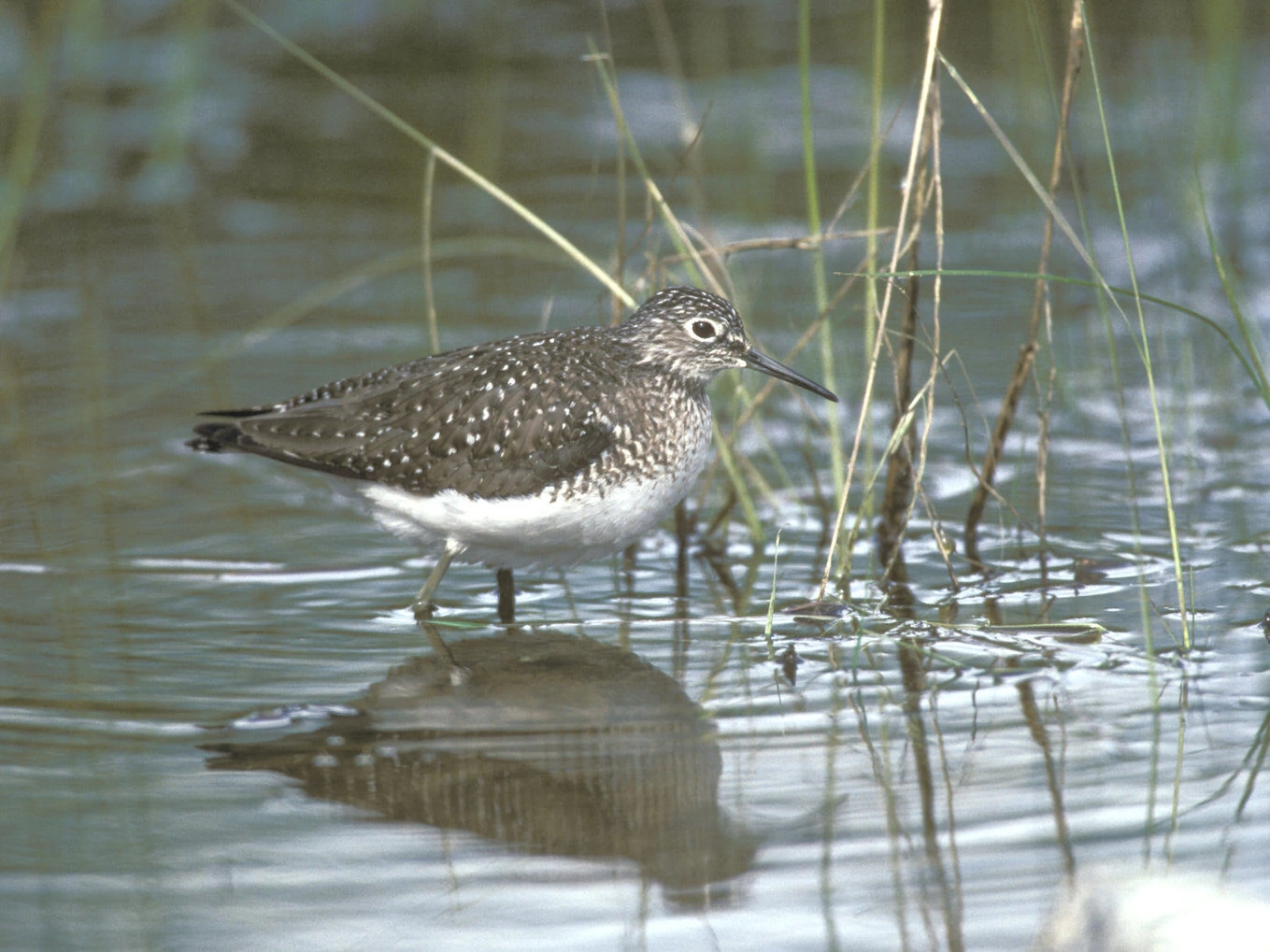
Solitary Sandpipers are spotted in Arizona during migration in April and from July to September.
Solitary Sandpipers are small shorebirds with long wings and legs. While most sandpipers migrate in flocks, Solitary Sandpipers, true to their names, migrate alone.
Their heads, necks, and breasts are finely streaked with brown and white and they have distinct white eyerings. Their bills are fairly long and dark. Breeding adults have backs and wings that are dark olive brown with white spots. Their legs are green.
Nonbreeding adults look quite similar to breeding adults except they are browner and their spots are less obvious.
- Tringa solitaria
- Length: 7.5 – 9.1 in (19 – 23 cm)
- Weight: 1.1 – 2.3 oz (31.1 – 65.1 g)
- Wingspan: 21.6 – 22.4 in (55 – 57 cm)
Solitary Sandpipers breed in Canada and migrate to Central and South America.
You can find Solitary Sandpipers in quiet freshwater wetlands and wooded swamps. In migration and winter, they favor habitats with hardly any other shorebirds like river edges and wet meadows.
Their nesting grounds are in muskeg regions, with bogs and ponds surrounded by spruce and other trees.
Solitary Sandpipers walk along muddy shores and in shallow water to hunt their prey. Most prey includes insects, crustaceans, mollusks, and amphibians. They normally shake one foot into the muddy waters to disturb the prey but also pick insects from plants.
Solitary Sandpiper call:
Nests of Solitary Sandpipers are old songbird nests and are unusually found in trees, contrasting with other shorebirds that nest on the ground.
Females lay three to five eggs and they take about twenty-four days to hatch. Once hatched, the chicks wait for their down to dry, and then they’re encouraged to drop down to the ground to start feeding.
Fun Fact: Solitary Sandpipers have two subspecies: Solitaria breeds and migrates east of the Rocky Mountains and Cinnamomea breeds and migrates west of the Rocky Mountains. Cinnamomea has narrower bars on the tail while Solitaria has broad bars.
16. Red-necked Phalarope
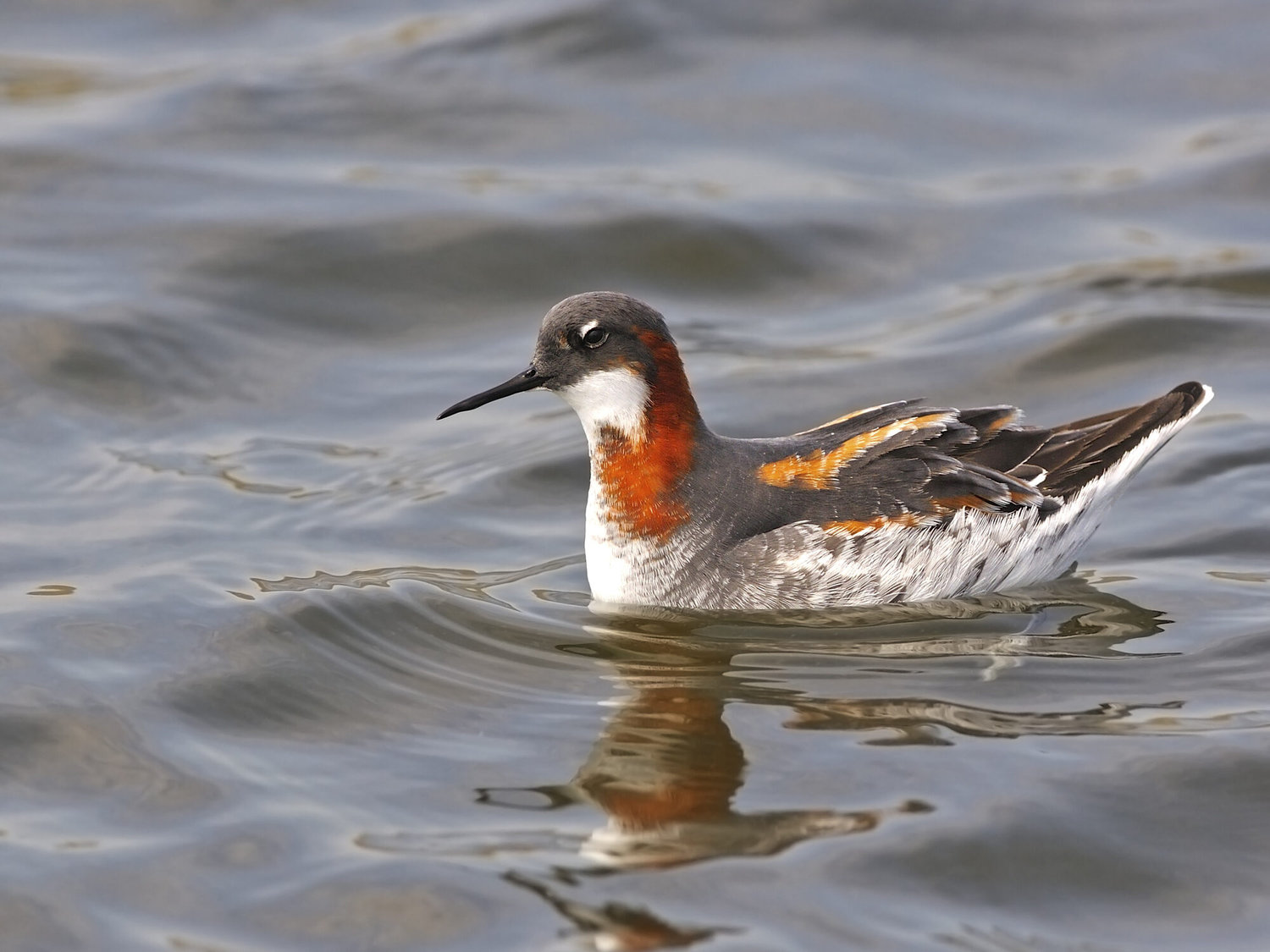
Red-necked Phalaropes are not very common in Arizona but they are spotted here during migration in May and from August to mid-October.
Red-necked Phalarope are small long-necked shorebirds with thin bills. They are black and white in the non-breeding season and gray with rusty necks in the breeding season.
Females are brighter than the males in the breeding season but they look the same in the non-breeding season. Juveniles are also black and white.
- Phalaropus lobatus
- Length: 7.1-7.5 in (18-19 cm)
- Weight: 0.9-1.4 oz (27-40 g)
- Wingspan: 12.6-16.1 in (32-41 cm)
Red-necked Phalaropes have a wide range, mainly in the northern hemisphere, but they are found as far south as northern Australia.
You can find Red-necked Phalaropes around lakes and marshes in the arctic tundra during the breeding season, but they usually spend winter out at sea.
Small aquatic invertebrates such as zooplankton are the main diet of Red-necked Phalaropes. They catch their food by spinning rapidly in circles on the surface of the water, which causes the invertebrates to swirl to the surface.
Red-necked Phalaropes calls:
Nests of Red-necked Phalaropes are built on mossy hummocks in the tundra and lined with grasses and sedges. They lay u to six eggs which take 3 – 4 weeks to hatch.
Fun Fact: Unusually, female Red-necked Phalaropes are larger and brighter than males and do the competing to win mates. The males however do all the incubation and caring of the young.
17. Willet
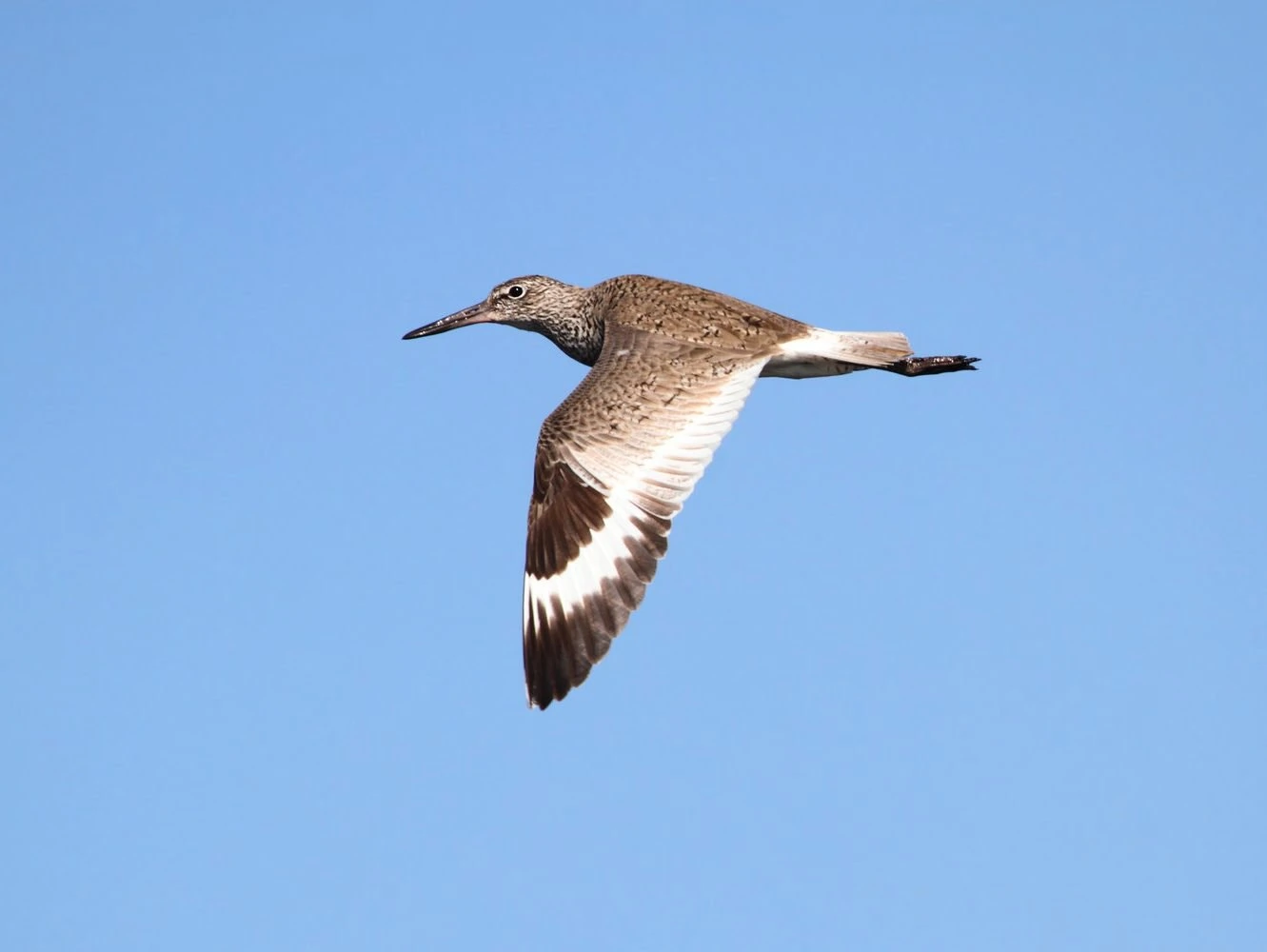
Willets migrate across Arizona and are usually spotted from mid-April to May and July to mid-September.
Breeding adult Willets are dark-brown with mottling on the back and white with some dark-brown streaking underneath. Their bills are thick and straight.
Their wings are distinct with broad white stripes on black wings visible in flight. Their tails are white with a dark brown tip. Their legs are long and bluish-gray.
Juvenile Willets are paler in comparison to adults and they hardly have any streaks on their white underparts, except on their throats.
There are two sub-species and Western Willets are lighter-colored in comparison to Eastern Willets. They also have less mottling on their upperparts and less barring on their underparts.
- Tringa semipalmata
- Length: 13 – 16 in (33 – 41 cm)
- Weight: 13.22 oz (375 g)
- Wingspan: 24 – 31 in (61 – 79 cm)
Willets that breed in northern US states migrate to coastal Central and South America. Most stay all year along the US coasts and Central American Coast.
You can find Willets on open beaches, marshes, mudflats, and rocky coasts. However, Western Willets move inland to freshwater prairie marshes and other wetlands for breeding.
Willets forage for food using their long bills to probe and pick small crabs, clams, worms, and other invertebrates from mudflats and saltwater marshes.
Willet Calls:
Nests of Willets depend on their location. Eastern Willets build their nests on the grass near salt marshes and dunes. Western Willets build their nests near pond edges.
Once the female decides on her preferred scrape, she will lay around four eggs that take two to three weeks to incubate.
Fun Fact: While both parents take turns incubating their eggs, only the male adult incubates at night and stays with the young even when the female has left their territory.
18. Semipalmated Plover
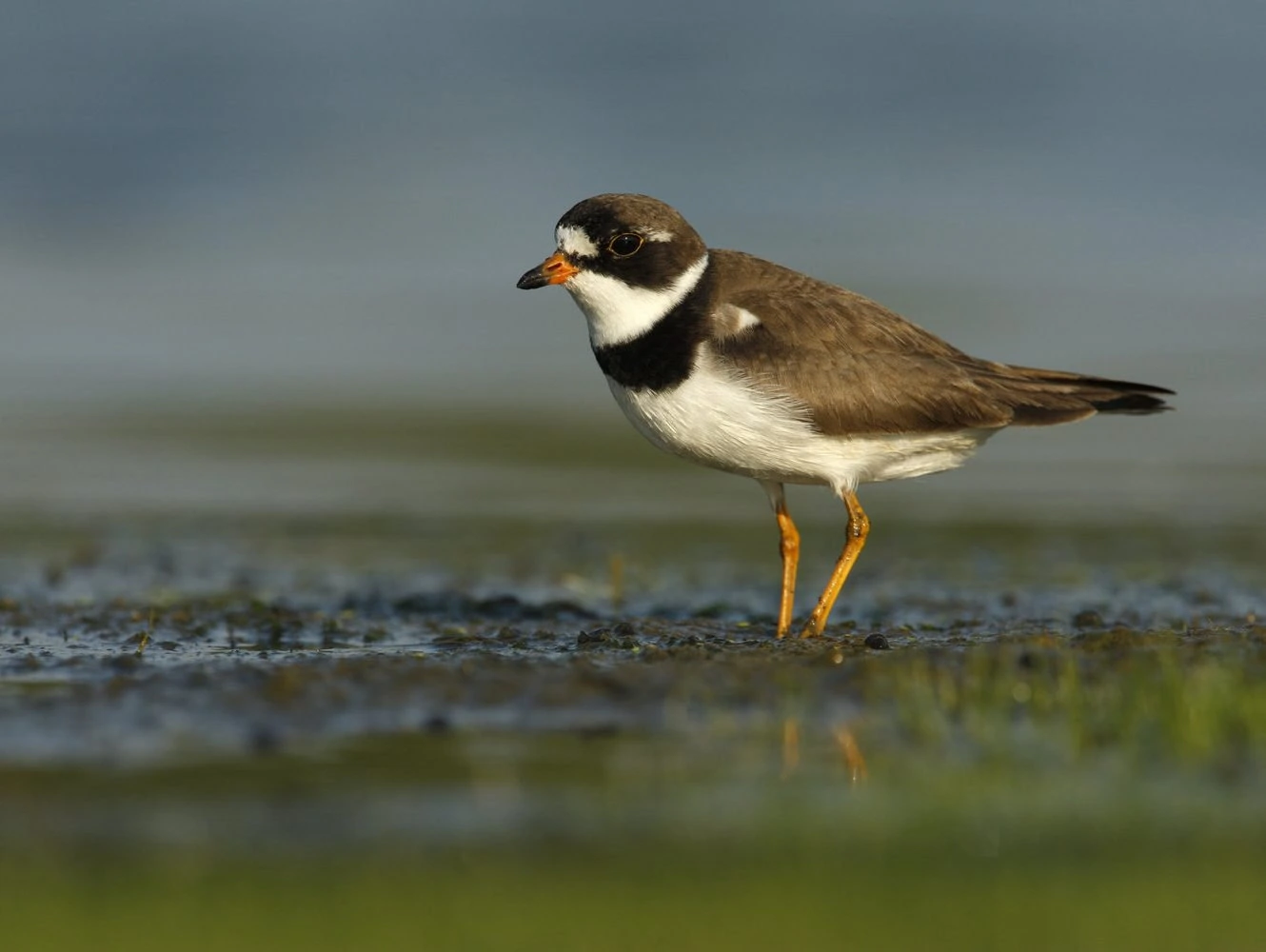
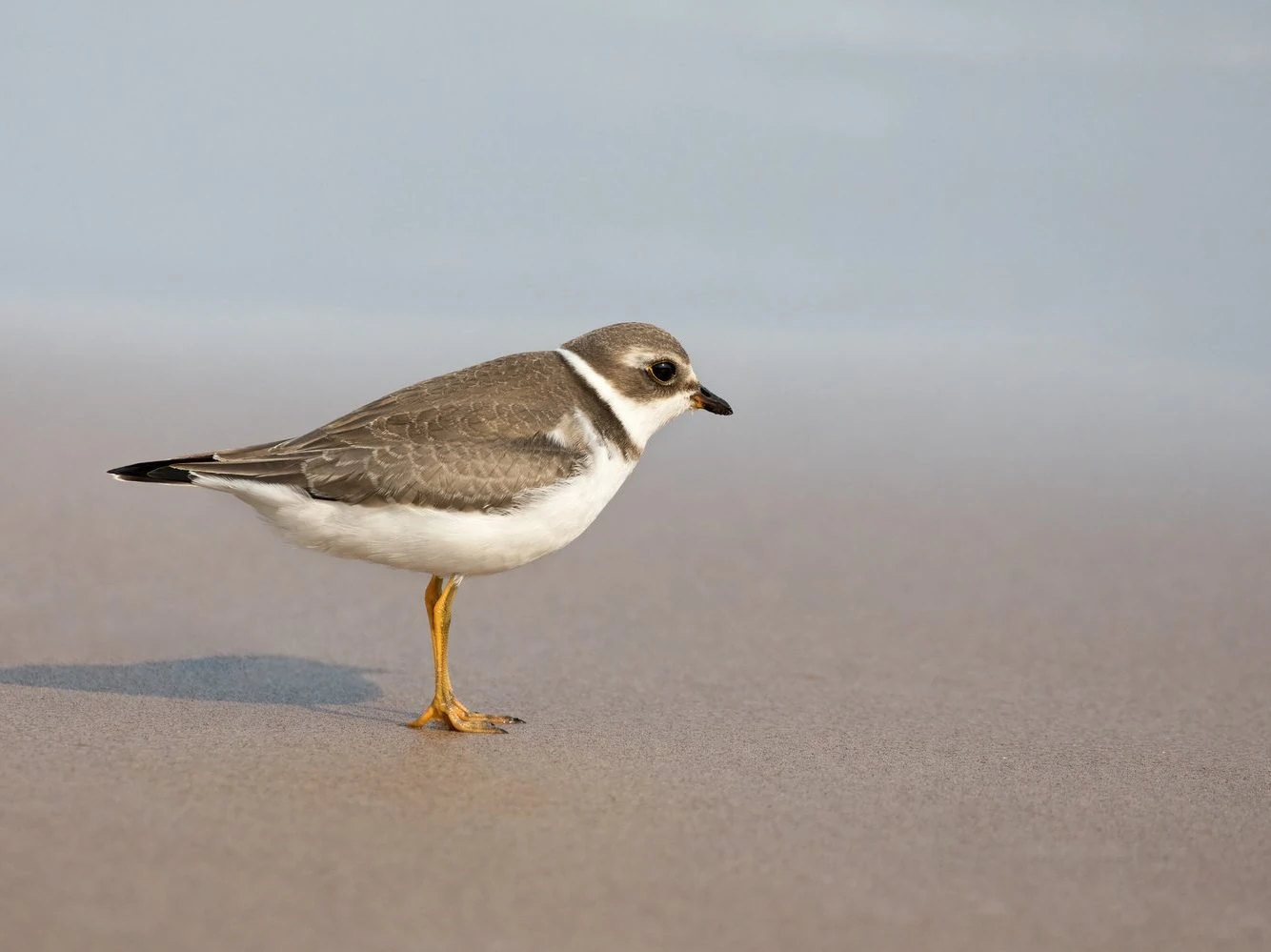
Semipalmated Plovers are not very common in Arizona but they are spotted here during migration in April and from August to September.
Semipalmated Plovers are small shorebirds noted for their stop-and-go foraging style.
Breeding adults are gray-brown on the back and white underneath. They have black collars and black masks with stubby orange bills.
Non-breeding adults are browner overall and without the full collar and mask. Juveniles look similar to adults but their collars and facial markings are barely noticeable.
- Charadrius semipalmatus
- Length: 6.5 – 7.5 in (17 – 19 cm)
- Weight: 2.43 oz (69 g)
- Wingspan: 14 – 15.25 in (36 – 39 cm)
Semipalmated Plovers that breed in Canada and northeastern US states migrate after breeding but those along the US, Central
You can find Semipalmated Plovers in the arctic tundra during the breeding season. They prefer sandy or mossy ground near water sources with low vegetation.
Semipalmated Plovers will dash across mudflats or in shallow water and then pause to scan the area. Prey usually includes worms, crustaceans, mollusks, and snails. In agricultural fields, they will feast on spiders, mosquitoes, grasshoppers, flies, and even plant seeds.
Semipalmated Plover Calls:
Nests of Semipalmated Plovers are made by males and lined with leaves, shells, rocks, moss, and seaweed. The female lays up to five eggs and both parents take turns with the incubation for about twenty-four days.
Fun Fact: The “Semipalmated” name of the Semipalmated Plover refers to its partially webbed feet.
19. Pectoral Sandpiper
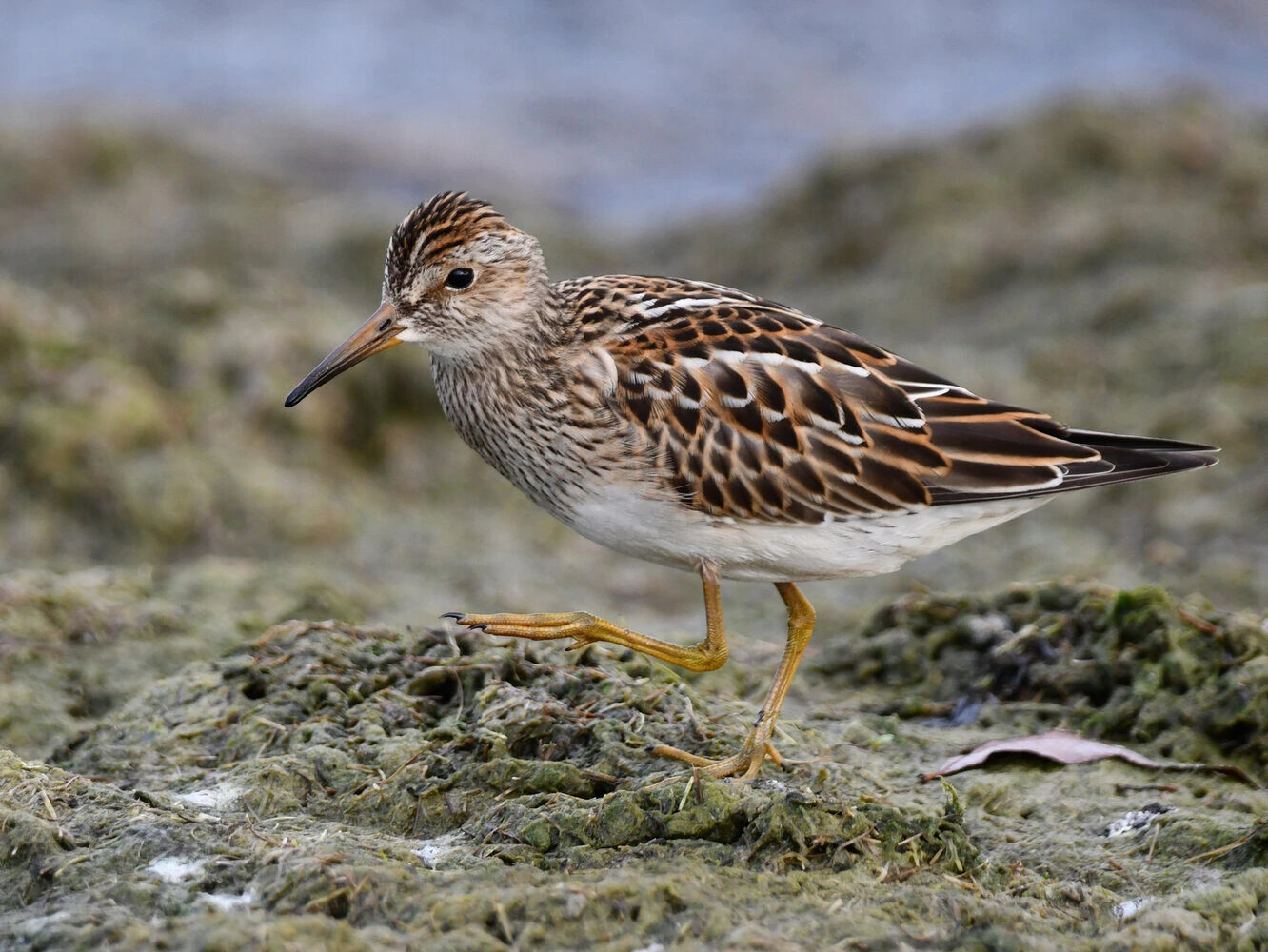
Pectoral Sandpipers can only be spotted during spring and fall migration in Arizona. However, they are most common in September and can be spotted in 1.6% of checklists at this time.
Pectoral Sandpipers are stocky, medium-sized “grasspipers” that are frequently seen on grassy marshes instead of mudflats.
Breeding adults are streaked and scalloped brown with white bellies, yellow legs, and bills that are darker at the top than the base.
Nonbreeding adults have a similar pattern of heavy streaking but are mostly gray or light brown. Juveniles are similar but they have finely streaked heads, necks, and breasts. Their backs and wings are brown with rufous edges.
- Calidris melanotos
- Length: 8 – 9.6 in (20 – 24 cm)
- Weight: 2.6 oz (73 g)
- Wingspan: 18 in (46 cm)
Pectoral Sandpipers breed in the Arctic and Great Plains and migrate to South America and Australia.
You can find Pectoral Sandpipers in grassy wetlands. Their breeding grounds are mostly in wet coastal tundra with a lot of grasses and sedges.
Pectoral Sandpipers mostly eat aquatic insects, small crustaceans, and very small fish. They usually poke and probe through grass and mud with their bills.
Pectoral Sandpiper call:
Nests of Pectoral Sandpipers are often depressions built on dry, raised ground and lined with grass and moss.
She will then lay four eggs that hatch after twenty-two days. The male does not help protect the eggs or rear the young. The young can fly in about three weeks.
Fun Fact: Pectoral Sandpipers get their “Pectoral” name from the inflatable air sacs on the males’ throats which puff up during courtship displays.
20. Dunlin
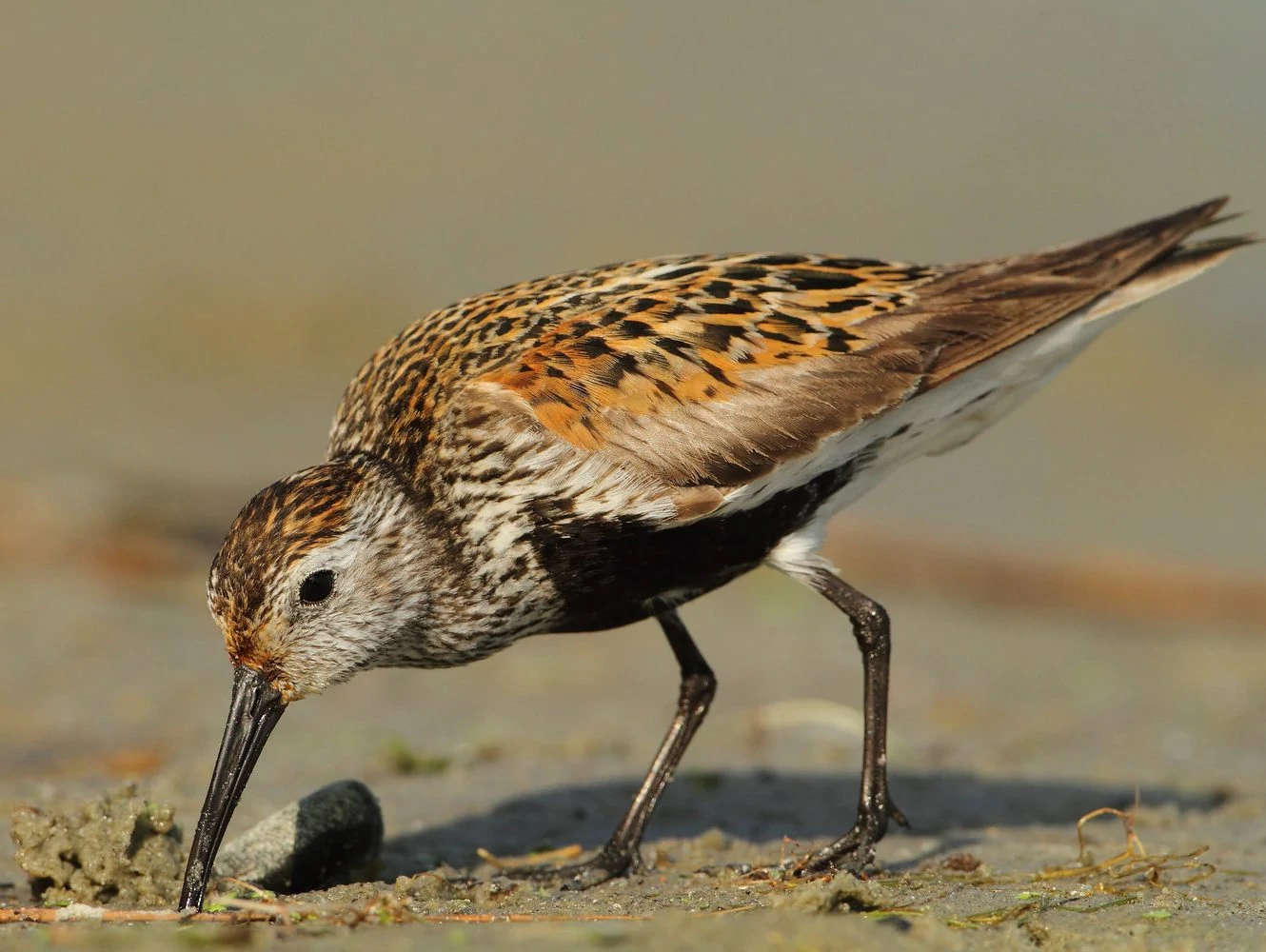
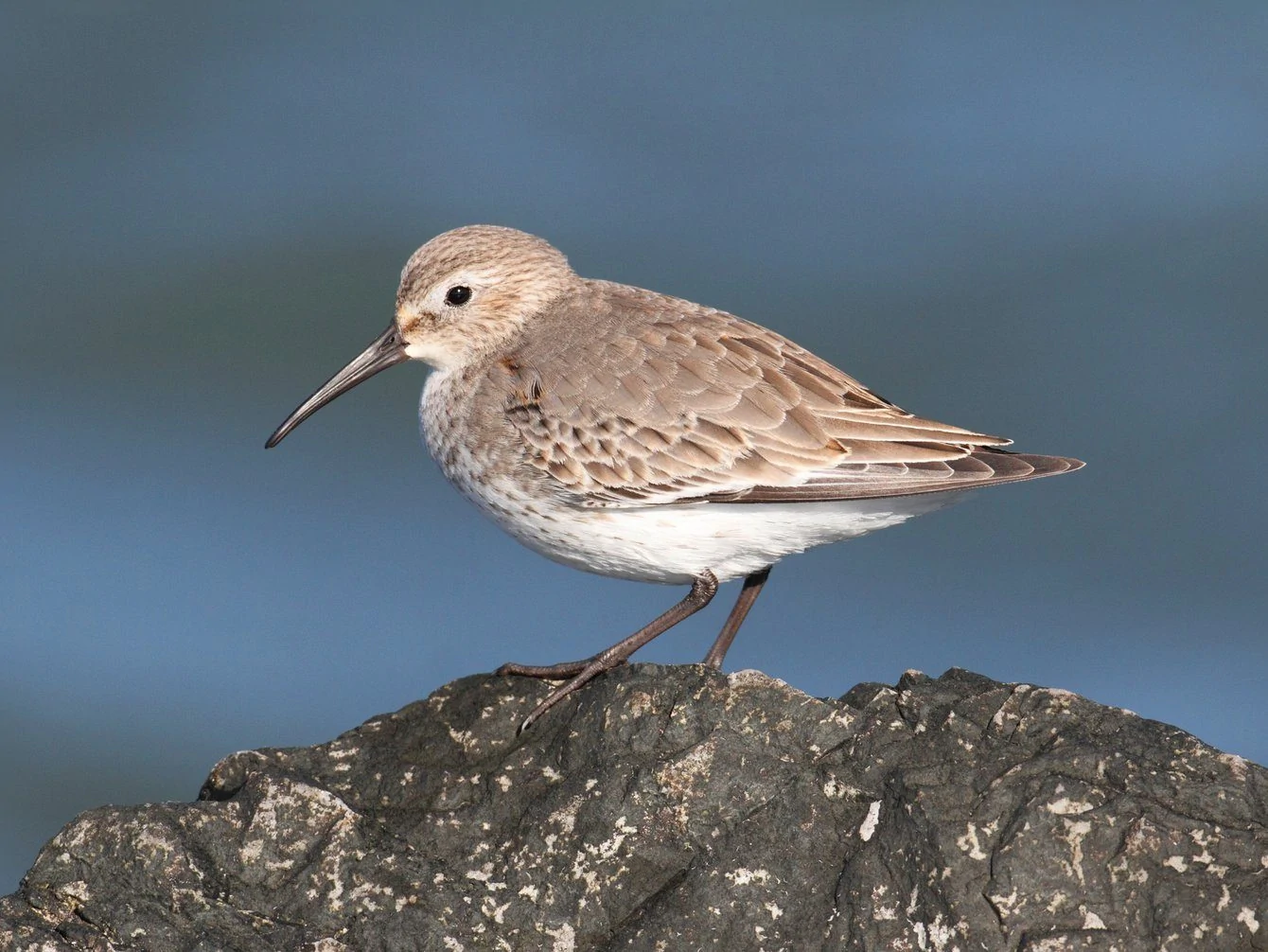
Dunlins are spotted in Arizona during migration and also during winter from October to January but they are not very common here.
Dunlins are small waders with distinctive black belly patches during the breeding season. They are mottled brown and are lighter underneath. They have short black legs.
Non-breeding adult Dunlins are gray on the back and pale underneath.
Juveniles share the same rusty-brown color as breeding adults but they’re paler in comparison and they do not have the black patch on their bellies yet. As they age, the black patch slowly appears.
- Calidris alpina
- Length: 7.5 – 8.5 in (19 – 22 cm)
- Weight: 2.99 oz (85 g)
- Wingspan: 14.5 – 15.75 in (37 – 40 cm)
You can find Dunlins near water in the subarctic and arctic tundra around the world during the breeding season. As Dunlins are social animals, they congregate in large flocks on sandy beaches and mudflats during migration and winter.
Dunlins love marine worms, mussels, small clams, snails and beetles, spiders, flies, and some seeds from plants. They pick off what they can see and they will probe in the mud for those that lay hidden.
Dunlin Calls:
Nests of Dunlins are scrapes on the ground built by males and lined with leaves, sedges, and grasses. Females lay three to four eggs which take around three weeks to hatch.
Fun Fact: While the long bill of the Dunlin looks sharp and pointed, it is actually blunt but is sensitive to touch, so they can continue eating well into the dark night just by probing through the mud and sand.
21. Marbled Godwit
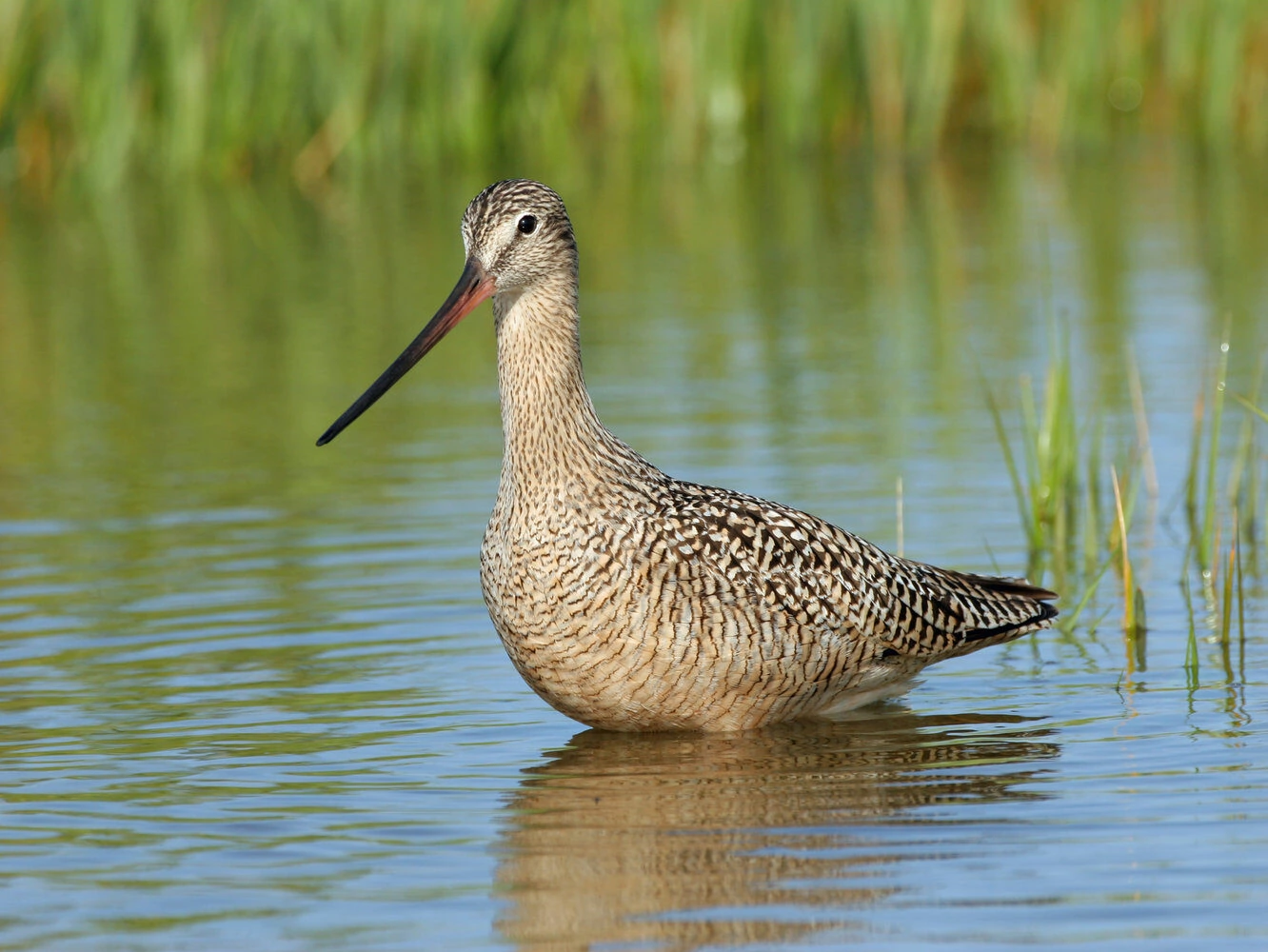
Marbled Godwits are usually spotted in Arizona during migration but they are not common in the state.
Marbled Godwits are striking shorebirds with their large cinnamon-colored bodies, long, swordlike bills, and long blue-gray legs.
Nonbreeding adults look like breeding adults except that they don’t have any barring or markings on their underparts. Their bills are also pink at the base, not orange, but still dark at the tips.
- Limosa fedoa
- Length: 16.5 – 18.9 in (42 – 48 cm)
- Weight: 10.1 – 16.0 oz (285 – 454 g)
- Wingspan: 27.6 – 31.9 in (70 – 81 cm)
Marbled Godwits breed in the Prairies of Canada and the Great Plains. They migrate to the coasts of the United States, and Central America.
You can find Marbled Godwits on mudflats, salt ponds, beaches, estuaries, and wetlands during migration and on wintering grounds where they congregate with other shorebirds. During the breeding season, they are often found in shortgrass prairies near marshes and ponds.
Marbled Godwits usually forage by probing deeply into water or mud with their long bills. They eat insects, mollusks, small fish, and crustaceans which they find by touch.
In their breeding grounds, they typically feed on terrestrial insects like grasshoppers as well as the roots and seeds of aquatic plants.
Marbled Godwit call:
Nests of Marbled Godwits are usually built on short grass on dry ground with a source of water nearby. The female lays three to five eggs which hatch in about three weeks.
When the eggs hatch, the young are capable of feeding themselves but their parents still tend to them. They are capable of flight in about three weeks.
Fun Fact: Marbled Godwits sleep standing on one leg while their bills are tucked into their body.
22. Mountain Plover
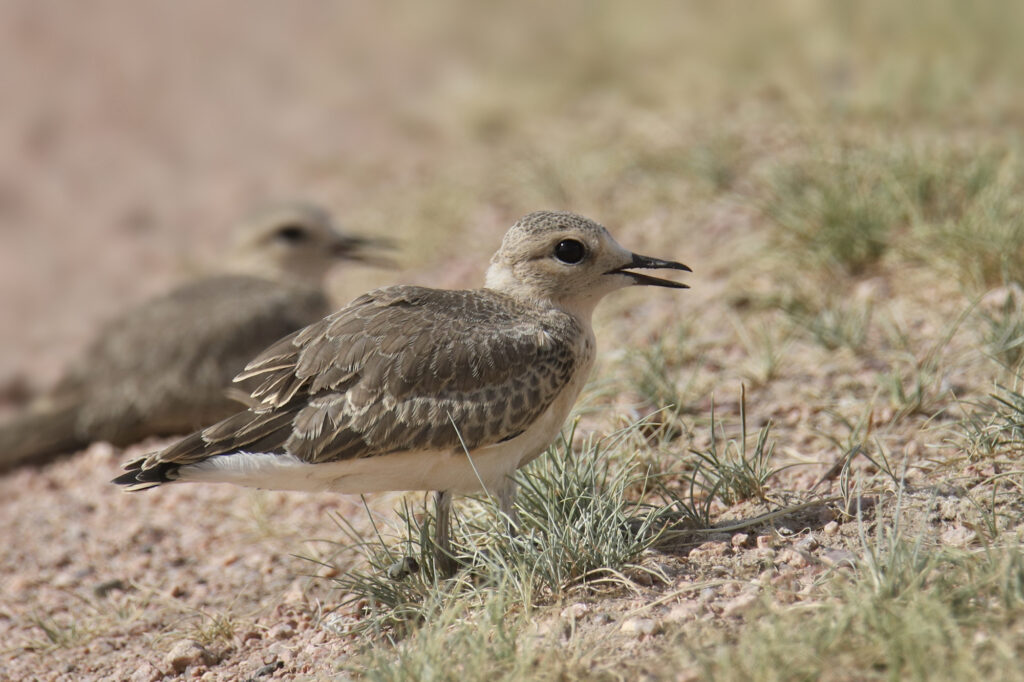
Mountain Plovers are near-threatened species in Arizona but some spend winter in the south of the state.
Mountain Plovers are medium-sized shorebirds that seemingly disappear into their surroundings when disturbed.
Breeding adult Mountain Plovers are tan or sandy brown on the back and white underneath with dark bills.
Nonbreeding adults and juveniles are similar with brownish heads and backs, and white underparts. They do not have the dark line between the eyes and bills like the breeding adults.
- Charadrius montanus
- Length: 8 – 10 in (20 – 25 cm)
- Weight: 3.7 oz (105 g)
- Wingspan: 17.5 – 19.5 in (44.5 – 49.5 cm)
Mountain Plovers actually breed in the Great Plains and migrate to southern US states.
You can find Mountain Plovers, not in the mountains as their name suggests, but in flat, open short-grass prairies. In winter, they will occupy plowed fields and coastal prairies.
Mountain Plovers mostly eat insects like grasshoppers, beetles, flies, ants, and crickets. They will usually run forward and then pause and peck when they spot something on the ground.
Mountain Plover call:
Nests of Mountain Plovers are often found on flat, open ground. They are made by males and are mostly just shallow scrapes on the ground next to animal droppings.
The female lays six eggs separated into two clutches. The first clutch with three eggs is incubated by the male. The second clutch of three eggs is then incubated by the female. Incubation lasts about a month.
Fun Fact: Mountain Plovers are considered “Near Threatened” because of the loss of habitat from crop planting and removal of prairie dogs.
23. Snowy Plover
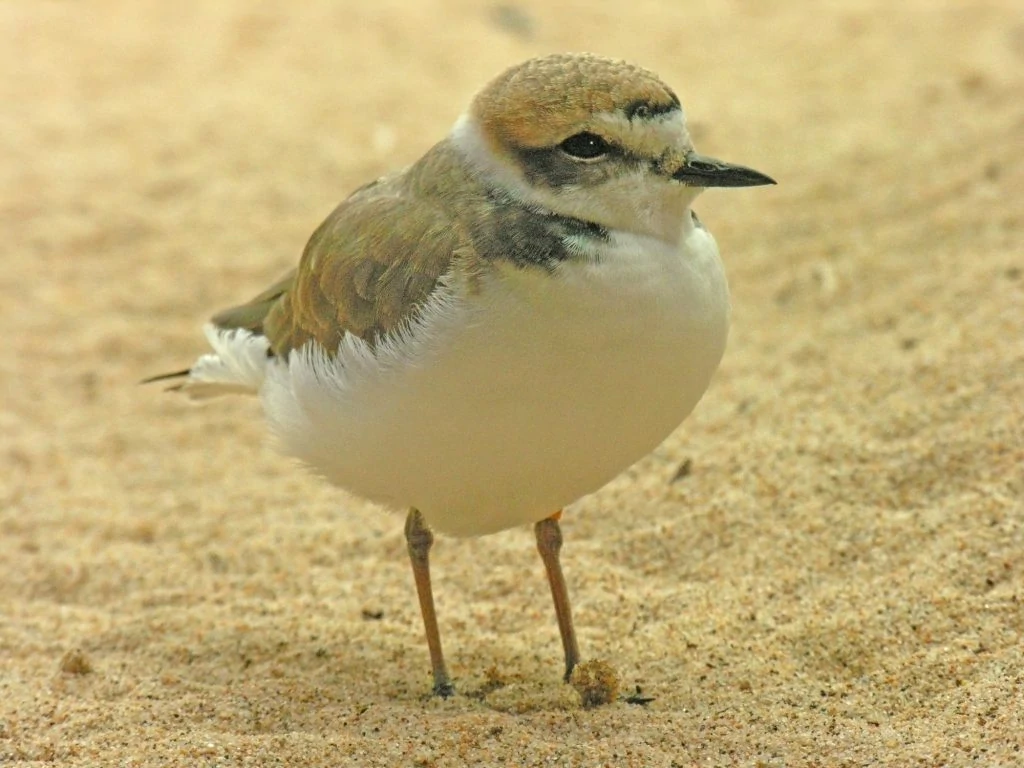
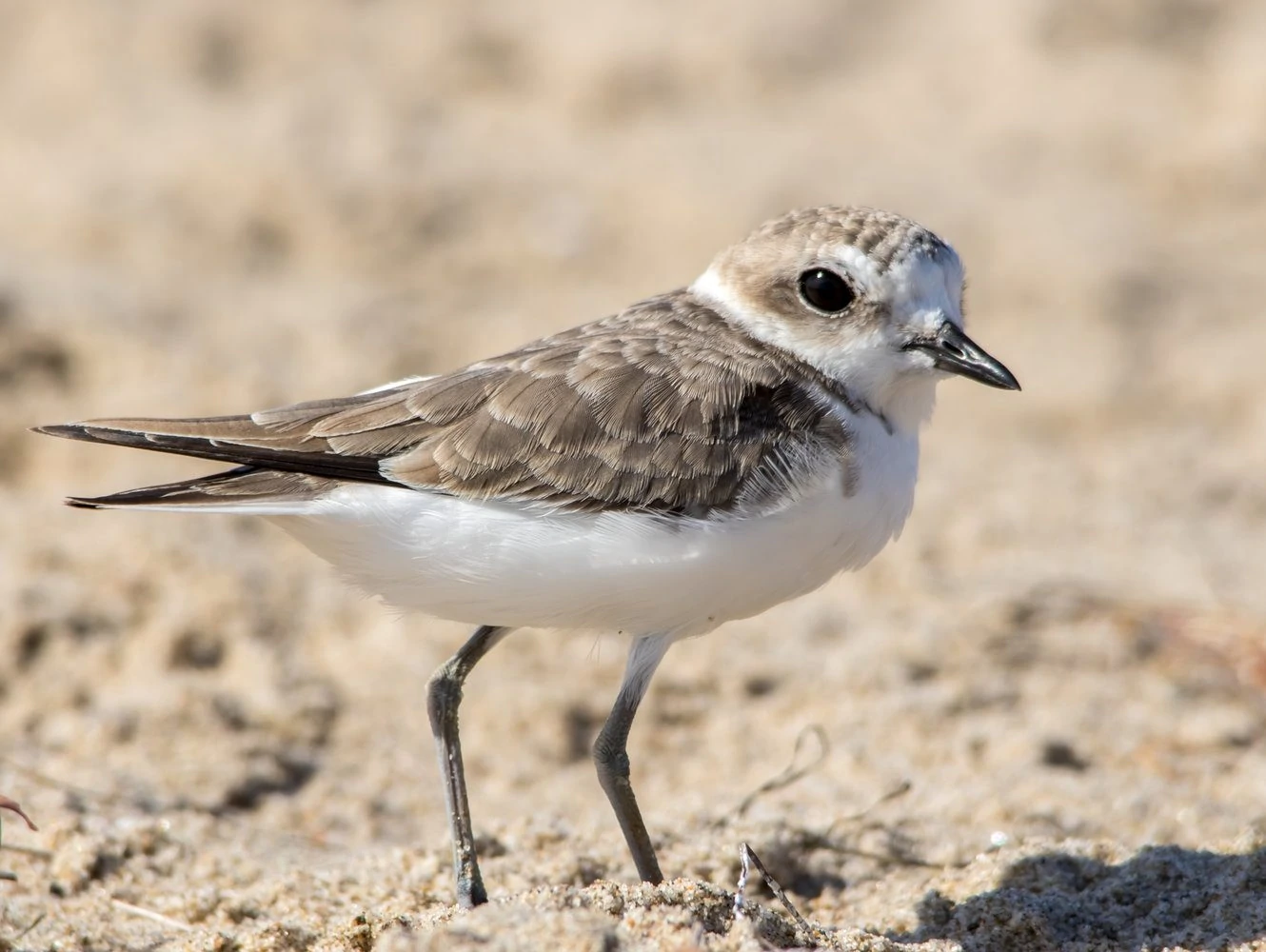
Snowy Plovers are near-threatened species in Arizona but some are spotted in the south of the state during migration.
Snowy Plovers are small waders known for their run and pause motion on sandy beaches. They blend well into the landscape because of the sandy tones on their upperparts.
Breeding adults have dark patches on the front of their crowns, at the back of their eyes, and on the side of their upper breasts, like a partial collar. Their bills are short and black and their legs and feet are dark gray.
Juveniles are a paler version of adults and have no dark face patches. Their upper parts are still a lighter sandy brown their neck stripe is also light.
- Charadrius nivosus
- Length: 6 – 7 in (15 – 18 cm)
- Weight: 1.4 oz (40 g)
- Wingspan: 13 – 14 in (33 – 36 cm)
Snowy Plovers breed in the Basin Steppe and the southern Great Plains. They migrate to the Gulf Coast and Central American coast. They remain all year on the West Coast and western and northern South America.
You can find Snowy Plovers on sandy coastal beaches and dry salt flats. They are also seen on shallow lakes. They prefer salt water over freshwater though. Their breeding grounds require sparse vegetation as a protective cover for the eggs.
They employ a run-and-pause motion when catching prey.
Snowy Plovers are active foragers on dry sand and sometimes in wetter areas as the tide rolls out. They are expert catchers of insects and crustaceans like worms, mole crabs, fly larvae, beetles, flies, snails, and clams.
Snowy Plover Calls:
Nests of Snowy Plovers are simple scrapes on the ground, usually beside a special feature like a plant or a shell. The female lays two to six eggs and she lines the nest with pebbles, shell pieces, and fish bones. It takes around a month to incubate the eggs and both parents share in this responsibility.
Fun Fact: Snowy Plovers have been listed as a threatened species since 1993 because the open nature of their nests makes it difficult to breed. Their nests on the beaches are prone to disturbance from humans or animals.
24. Sanderling
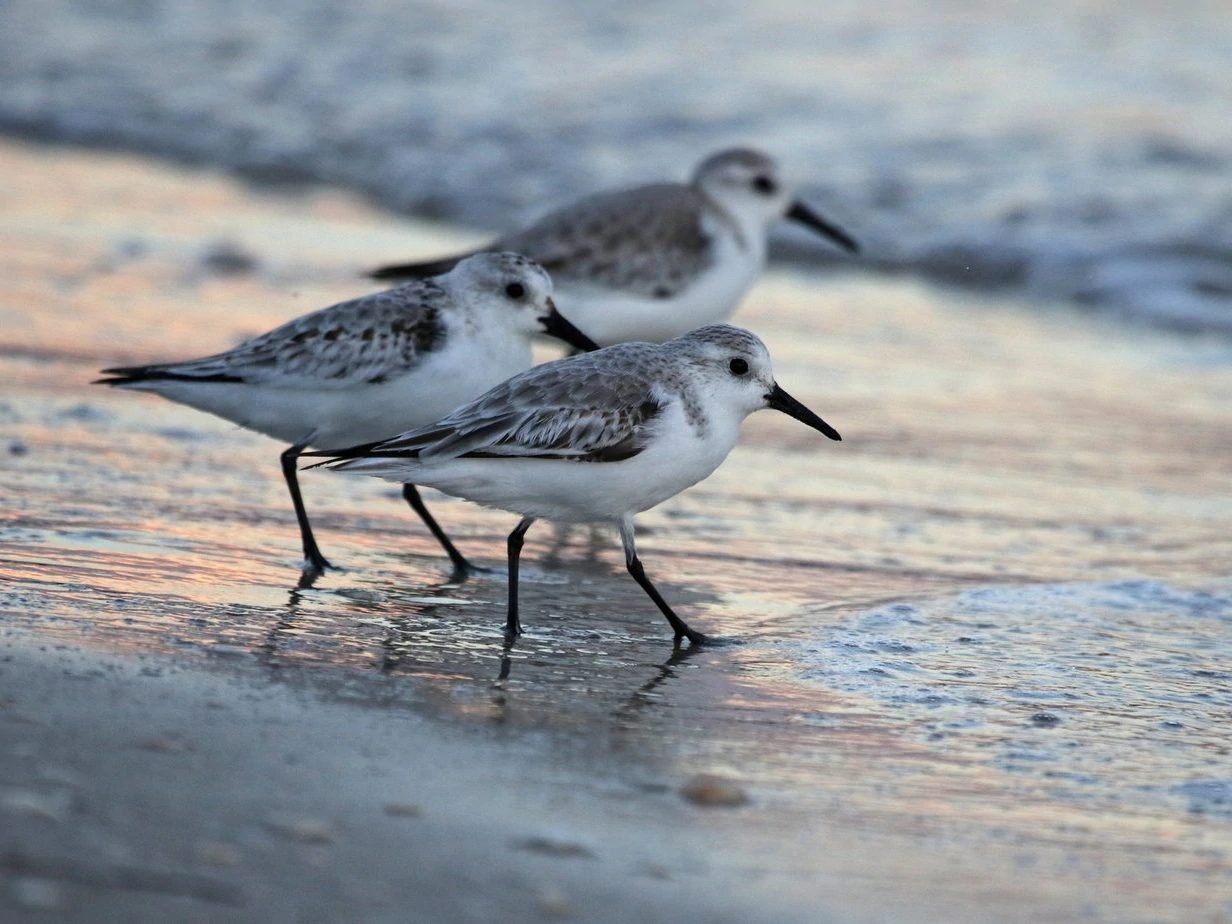
Sanderlings are not often spotted in Arizona but there have been some sightings in the state during migration.
Sanderlings are small, stout, and feisty birds commonly found chasing after the waves.
Their non-breeding coloring is pale gray, almost white, on their heads and upperparts and white on their underparts. Their bills and legs are black, in contrast.
Breeding adult Sanderlings have reddish-brown mottling on their heads, breasts, backs, and wings. Their bellies and rumps are white. They have black bills and legs.
Juvenile Sanderlings have dark gray heads and their backs and wings have a mottling pattern.
- Calidris alba
- Length: 7.1 – 8.7 in (18 – 22 cm)
- Weight: 2.1 oz (60 g)
- Wingspan: 17 in (43 cm)
You can find Sanderlings practically on any sandy beach across the world, particularly during winter. While their breeding grounds are exclusively in the High Arctic tundra, they migrate along the North American coast.
It’s entertaining to watch Sanderlings as they forage on the beach. They look for food as a group, running along the shore after a wave recedes. They usually eat small crabs and during summertime, they can also catch flying insects.
Sanderling Calls:
Nests of Sanderlings are usually located on the ground, in dry and stony areas. The female creates a shallow spot on the ground lined with soft material and pebbles and then lays about four eggs. The eggs take three to four weeks to hatch.
Fun Facts: Non-breeding adults don’t make the trek toward their breeding grounds in the Arctic and simply remain in their wintering grounds throughout the breeding season.
25. Black-bellied Plover
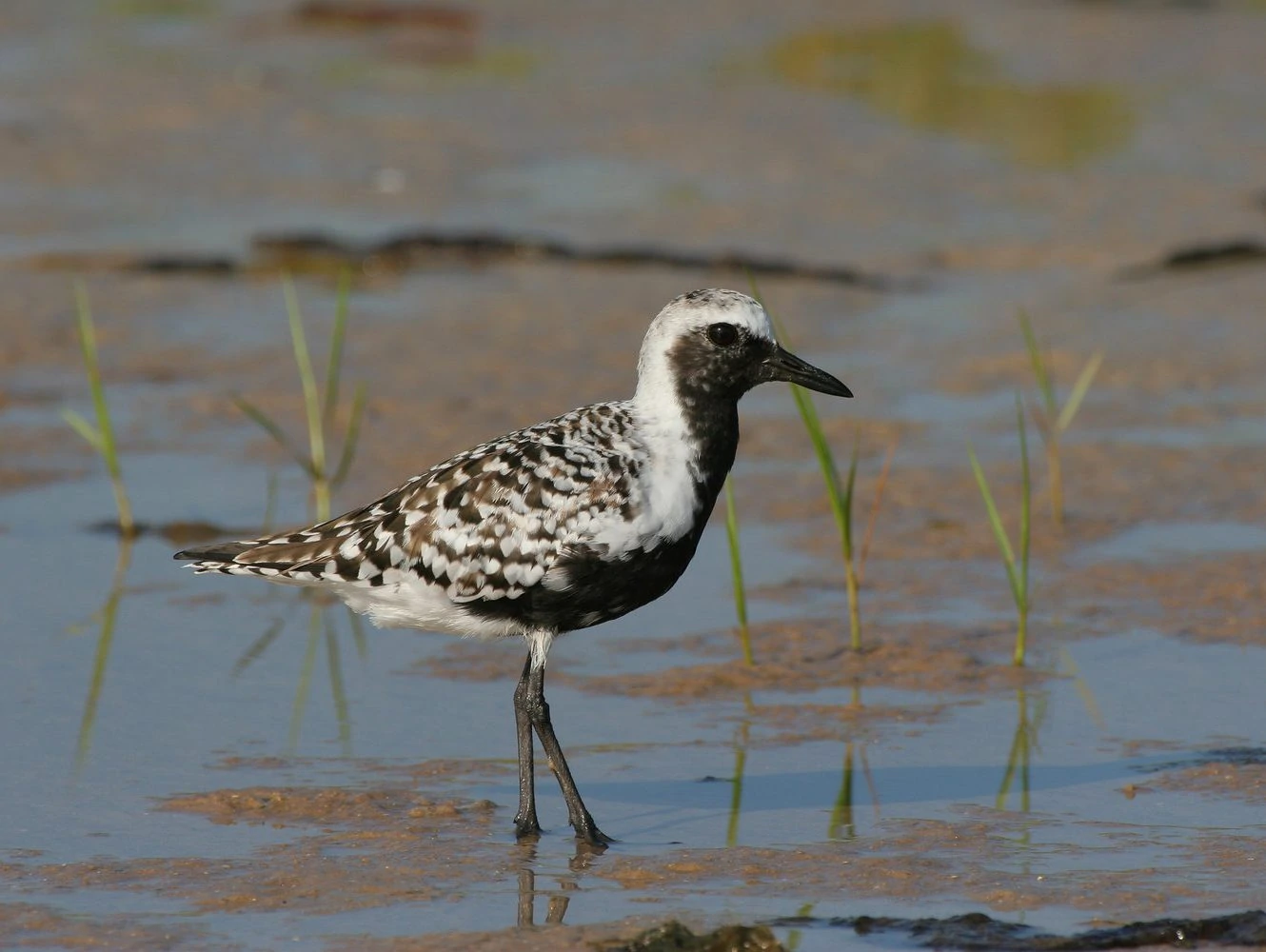
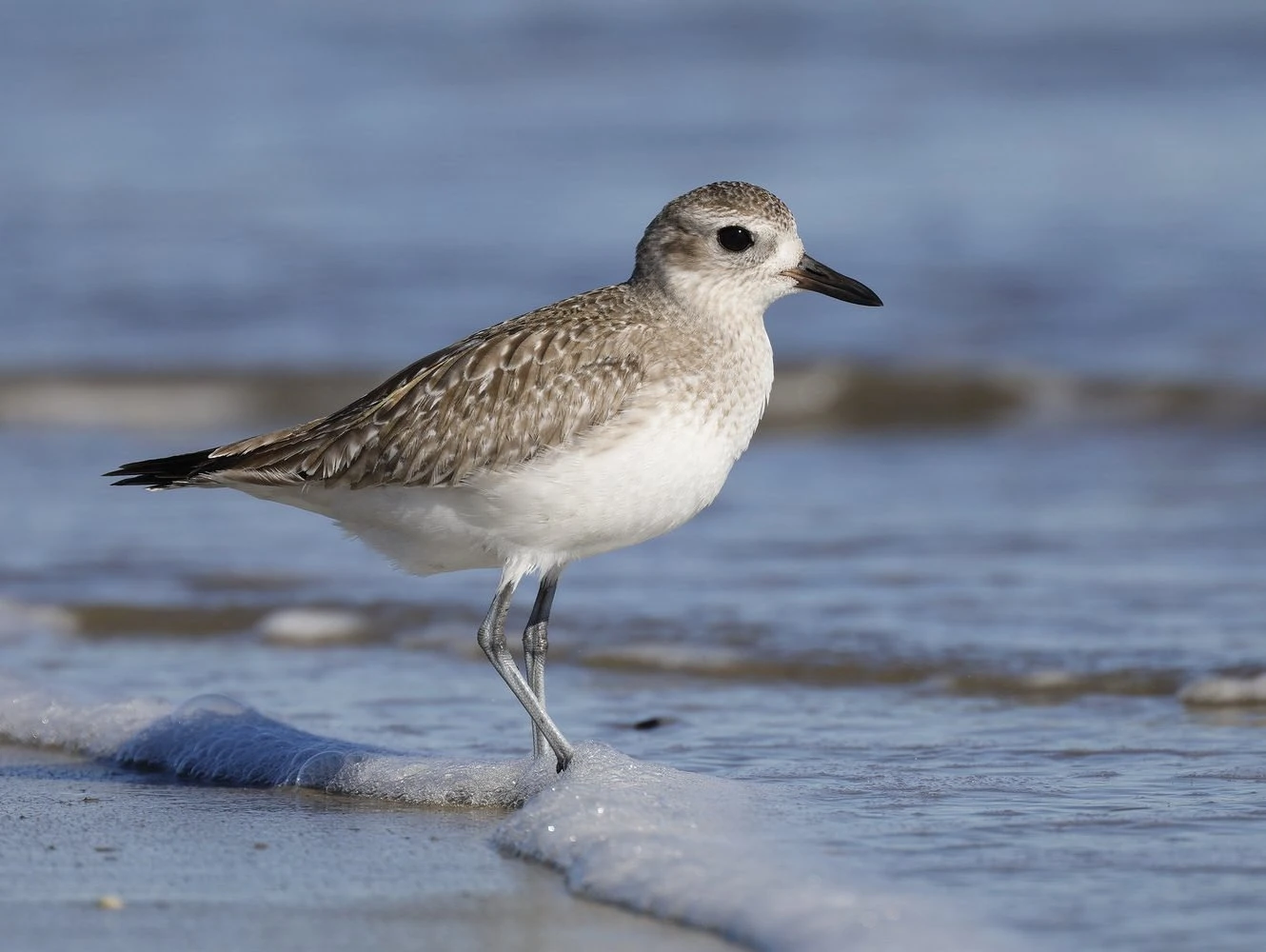
Although they are not very common here, Black-bellied Plovers have been occasionally spotted in Arizona during migration.
Breeding adult Black-Bellied Plovers are uniquely patterned water birds. They are mottled black on the back and are black from their bills to their bellies with a white border between.
Breeding females are less black than males. Non-breeding adults are grayer overall and with white bellies.
Juveniles are similar, but their upperparts have pale yellow spots and they have faint streaks on their flanks and breasts.
- Pluvialis squatarola
- Length: 11.5 – 13 in (29 – 33 cm)
- Weight: 11.28 oz (320 g)
- Wingspan: 22 – 25 in (56 – 64 cm)
Black-bellied Plovers breed in the arctic north before migrating south to coastal areas for winter. In North America, they migrate to both the east and west coasts of the United States from Canada.
You can find Black-bellied Plovers on the tundra during the breeding season. In winter, you are most likely to find them along coastal areas like beaches and mudflats.
Black-bellied plovers usually eat invertebrate prey like insects, worms, and crustaceans which they get from dry, muddy, and sandy grounds. Their diet in their breeding grounds consists mostly of larvae of flies, beetles, moths, and butterflies and they also eat berries, and seeds.
Black-bellied Plovers Calls:
Nests of Black-bellied Plovers are simple scrapes on the ground made by the males. The females then line these scrapes with moss, lichen, and other plants.
The female lays three to four eggs which both parents incubate for three to four weeks.
Fun Fact: The Black-bellied Plover is known as “gray plover” in the Old World (Asia, Africa, and Europe) and “black-bellied plover” in the New World (the Americas).

